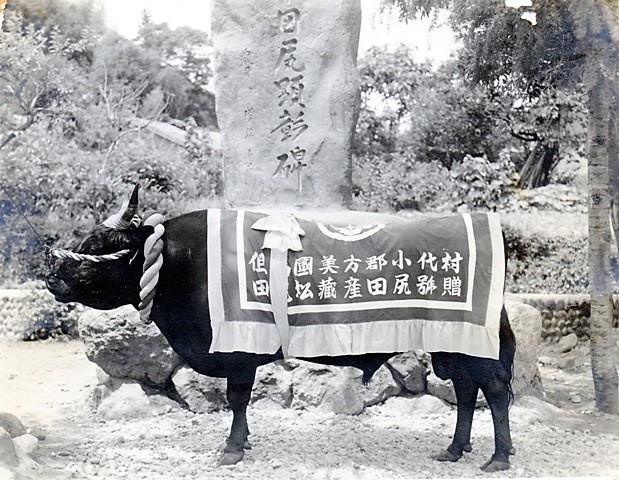About Japanese Wagyu
Charm of Japanese Wagyu
As you know, Japanese Wagyu beef is renown for being tender and delicious. Actually, this delicious flavor is made possible by the hard work of farmers who specialize in fattening cattle, as well as by strict quality management. This video introduce the charm of Japanese Wagyu beef going far beyond flavor alone. (Produced by the Japan Livestock Products Export Promotion Council)
Charm of Japanese Wagyu beef is an easy-to-follow video explaining all phases from raising of cattle to exporting of beef. The video introduces the quality checks conducted prior to export, as well as the evaluation of Japanese Wagyu beef throughout the world.
The video explains the charm of Japanese Wagyu beef in an easy-to-follow format, so it is recommended for people just beginning their study of Japanese Wagyu beef.
Everything about the Japanese Wagyu
The overall decoration of the Meat Boutique’ interior is bright and clean like a fashion boutique, and the walls are made out of marble to break people’s impressions of meat boutiques. The raw and cooked meat are placed in separate areas, and the Boutique has a meat slicer that costs over NTD $500,000. Customers are very surprised during their first visits to the RÒU by T-HAM Meat Boutique. The spacious interior and excellent design of the Meat Boutique has garnered the “2017 Red Dot Product Design Award,” and an award as an entry in the Indoor Retailer group at the “2017 World Architecture Festival Awards,” which is the equivalent of an architectural Oscars award.
The 2nd Floor has a dining space that can seat 30 people, and is filled with the warm aroma of hot pots.
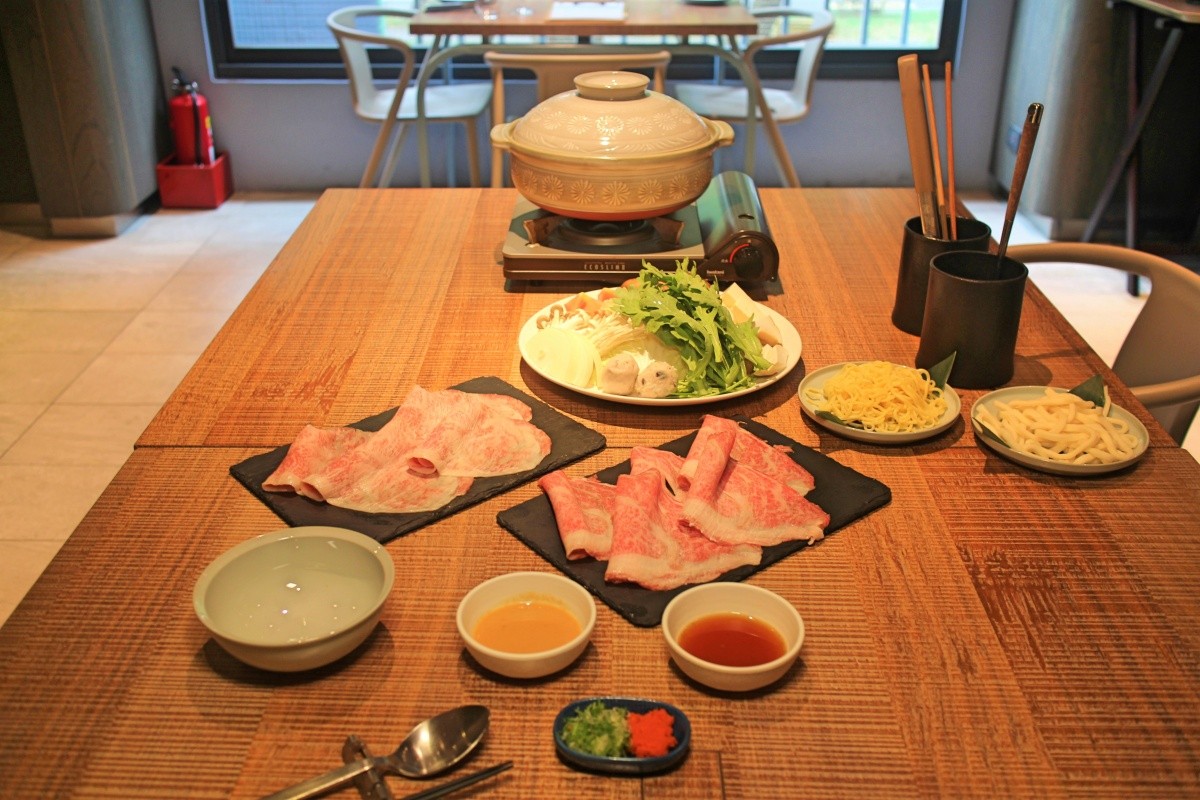
“The Japanese Nabemono is simple, as the broth is mostly clean water with a single piece of sea tangle, so that people can taste most original flavor of the ingredients.”As explained by the chef there is some difference between Taiwanese and Japanese shabu-shabu. In Japan, the locals first blanch the meat and then eat the vegetables. When the sea tangle broth is enriched with the taste of the vegetables and the fresh meat products, the rice is then cooked inside the broth with other ingredients. They proceed to eat the mixed pot of ingredients with Japanese pickled foods.
However, the people of Taiwanese enjoy numerous types of tastes and a large variety of dishes. Therefore, Taiwanese hot pot restaurants usually have multiple broths and more than ten types of sauces. The Boutique’s shabu-shabu offers two kinds of broths to enrich the customers’ taste buds and allow them to enjoy the authentic local taste. The first broth is a fresh pork bone broth that is slowly simmered with 500 kg of pork leg meat. The second broth is a fresh pork bone broth that is mixed with kasu miso. The sauces that come with the shabu-shabu also stay true to Japanese tradition, as it is a combination of orange vinegar and sesame sauce made from fresh limes and oranges. Spicy radish puree and chopped green onions are also included to bring out the taste.
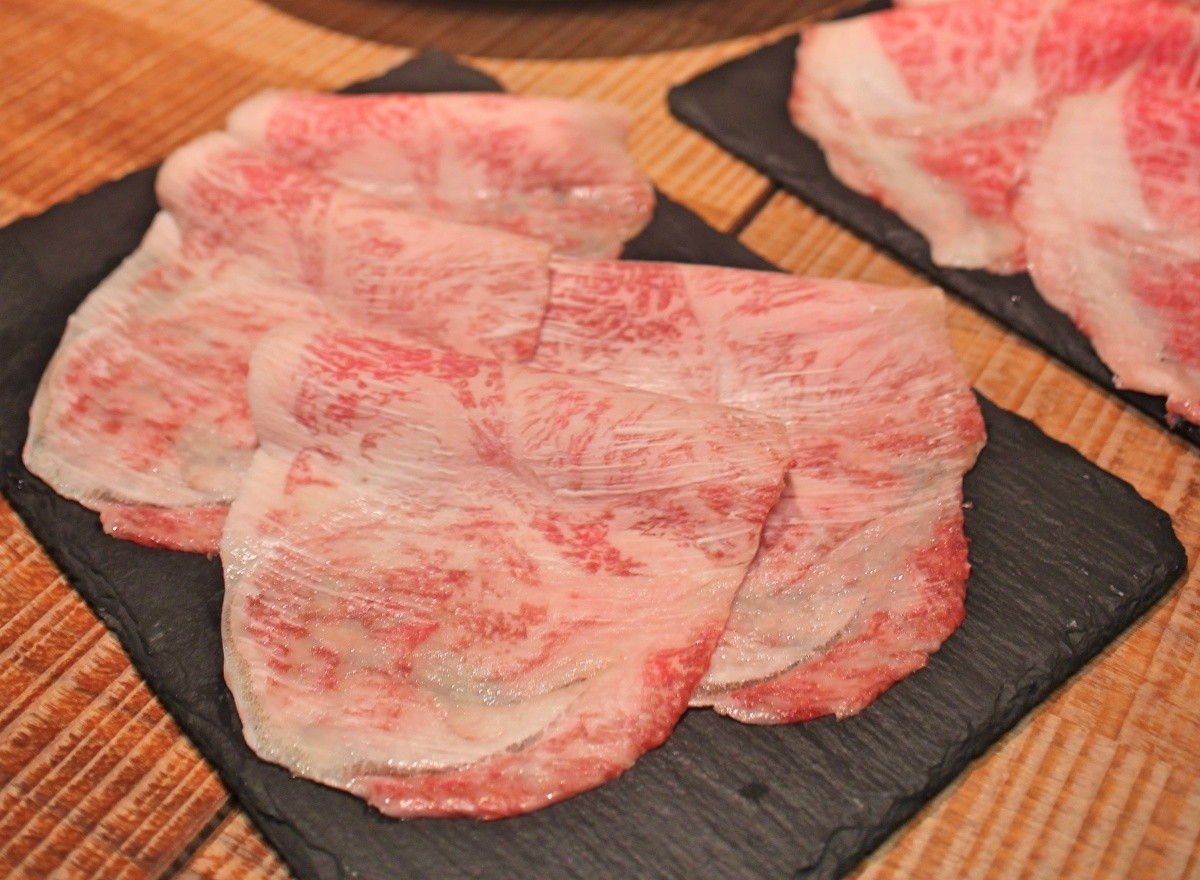
The main attraction of the shabu-shabu is the Japanese Wagyu slices. The restaurant provides customers with choices regarding the origins and cuts of the beef cattle. The origin of the premium Japanese Wagyu includes cattle from Miyazaki, Omi, Kagoshima, Hokkaido and other provinces. The cuts of the cattle include the short loin, sirloin, chuck and other cuts. Miyazaki, the rising star of all Japanese Wagyu cattle, won the "National Japanese Wagyu Competency Competition" for three consecutive times since 2007. It is characterized by rich and dense marbling, and has hint of peach and coconut. What makes the Miyazaki Wagyu special is that the milky and fruity scents are often detected as the beef products are being processed, making them taste even more delicious. The Miyazaki short loin appears to be whiter than other cuts due to its wider and thicker marbling. On the other hand, the rib eye has a delicate and highly-dense marbling and is usually referred to having very beautiful “marbling.”
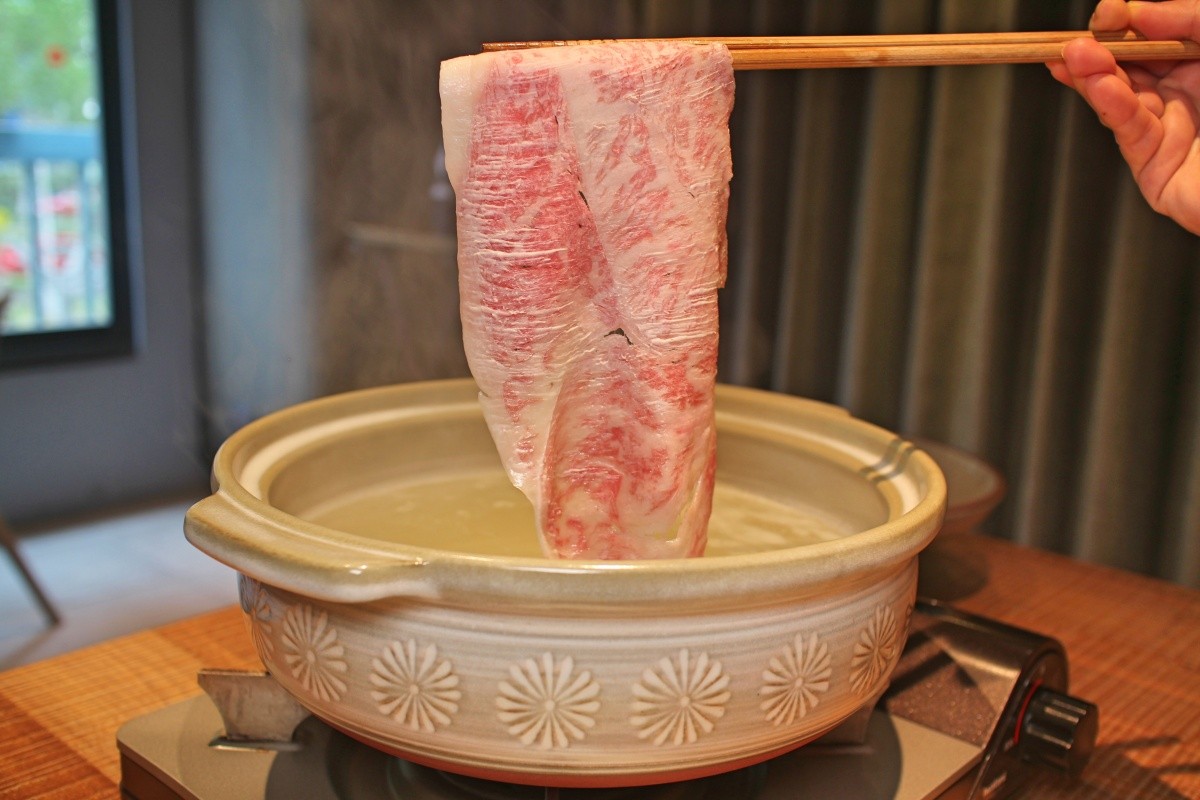
The Boutique slices the Miyazaki short loin into large Wagyu slices that are only 20 mm thin for the shabu-shabu. These Wagyu slices only need to be blanched for 5-6 seconds and can be eaten medium rare, and the pinkish-rose color of the Wagyu slices make them deliciously tempting. The Miyazaki short loin’s quality remains unaffected even if the Wagyu slices are blanched for too long. If customers are afraid of eating them medium rare, the Wagyu slices can boiled till they’re well done. The Miyazaki rib eye has a rich amount of fat that splits the meat blocks, therefore the Wagyu slices are best folded in half before blanching them. The Wagyu slices can then be gently opened up to prevent them falling apart, affecting the appearance and taste. Foodies that enjoy an abundance of beautiful marbling can’t afford to miss out on the Miyazaki rib eye.
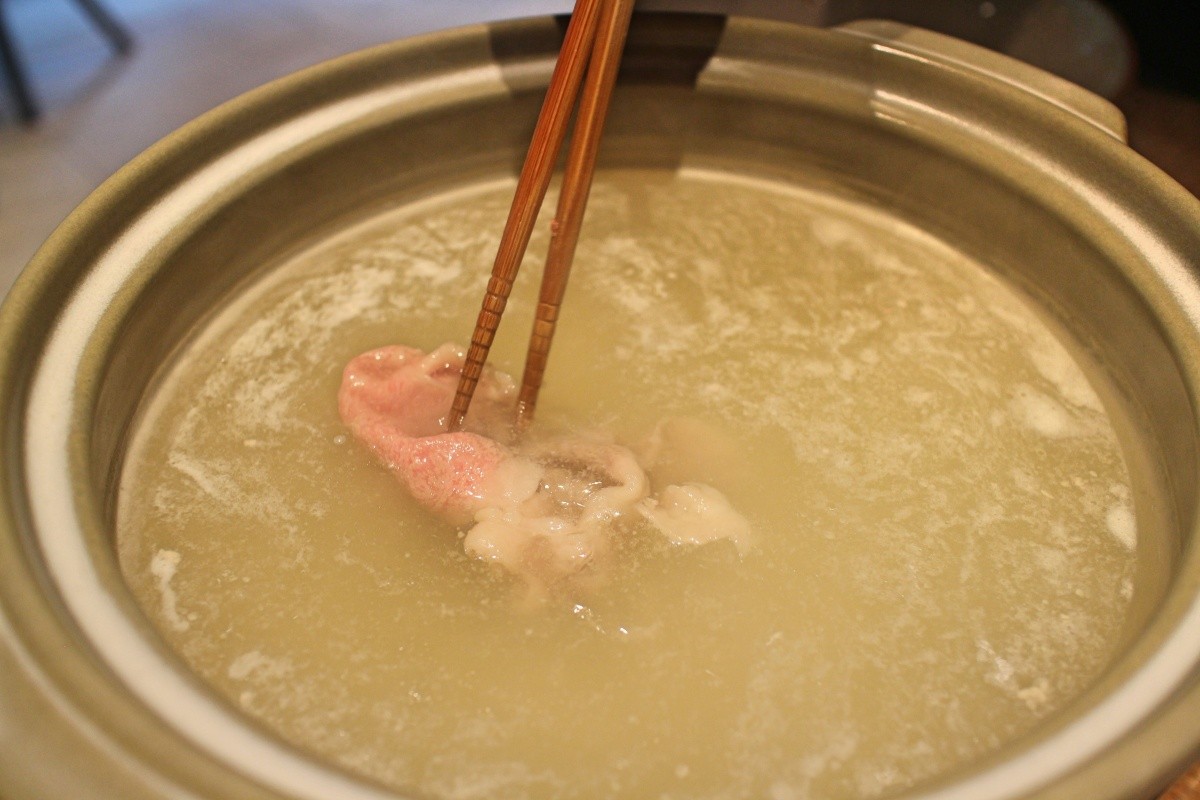
Customers can begin by trying the original taste of the Miyazaki rib eye, which has absorbed the slightly salty broth. The customers can then try it with the orange vinegar and sesame sauces to experience different tastes and fragrances. Customers must make sure to add the handmade noodles or Udon noodles into the broth, and enjoy feasting on the delicious noodles that have absorbed the broth after eating Japanese Wagyu and seasonal vegetables.
The Boutique has also begun offering Miyazaki Wagyu short loin barbeque with mountain pepper. This offering is based with stir-fried onions and mushrooms, and the Japanese mountain pepper sauce brings out the sweet taste of the Miyazaki Wagyu. The rich marbling of the Miyazaki Wagyu embellished with mountain peppers gives it even more taste. However, shabu-shabu remains one of the best choices to truly enjoy the quality and taste of premium Japanese Wagyu. Not only are customers allowed to fully experience Japanese culture through Japanese Wagyu, customers can simply blanch Japanese Wagyu in the gentle broth to highlight the sweet taste of the meat products.
RÒU by T-HAM
Address: No. 326, Dunhua South Road Section 1, Da’an District, Taipei City, Taiwan 106
Official Website: www.facebook.com/roubytham
1st Floor Meat Shop
Business Hours: Every day from 11:00 - 21:30 (Holidays will be announced separately)
Call 02-2755-2606 for more information
2nd Floor Dining Area
Business Hours: Every day from 11:30 - 21:30 (Holidays will be announced separately)
Call 02-2755-2608 to make an appointment
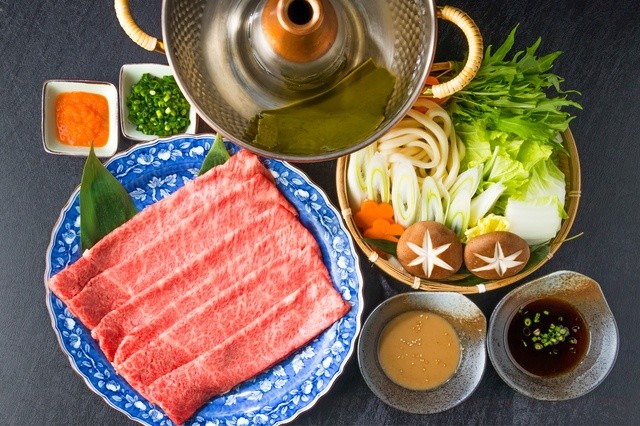
As a Taiwanese, I’ll feel uncomfortable if I don’t have shabu-shabu once or twice per week regardless of the weather. However, everyone has become more conscious about their health and they inevitably have concerns about the high-calorie Taiwanese hot pot stocks, ingredients and sauces. So, I am here to tell everyone about a super refreshing way to enjoy Japanese shabu-shabu. There is no need to worry about ingesting excessive calories from the stock or the sauces as the simple and refreshing way of eating shabu-shabu allows people to enjoy the premium taste of Japanese Wagyu even more!
So how should people select their Japanese Wagyu slices? The taste and smell of the Japanese Wagyu are both equally important.
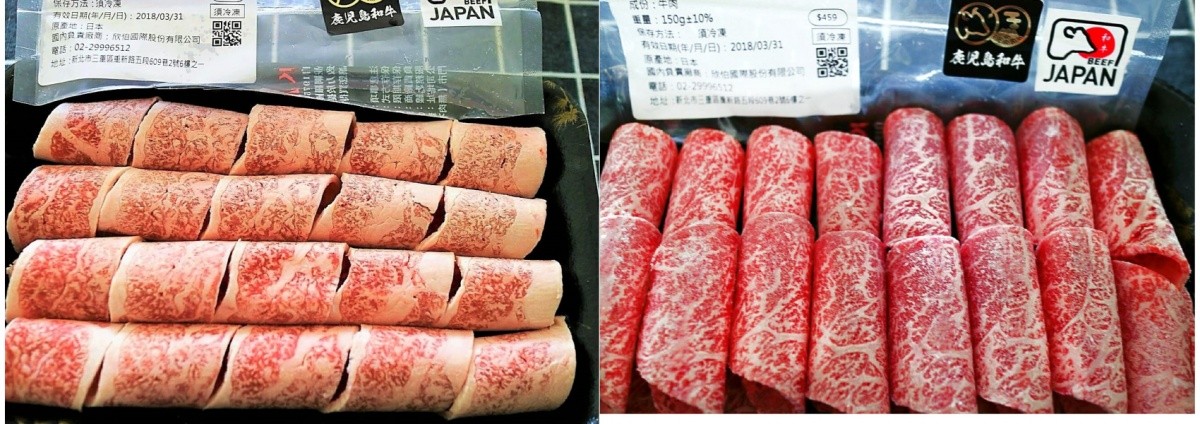
I usually decide the recipe first and then compare ingredients at different places when selecting Japanese Wagyu slices. I selected two types of A5 thin-cut Japanese Wagyu slices for this occasion since this recipe primarily features Japanese shabu-shabu. The slices on the left are thin-cut short rib Wagyu slices, which has beautiful marbling and sweet-tasting fat that goes very well with vegetables. The slices on the right are thin-cut strip loin Wagyu slices, which also have beautiful marbling and are very tender after they’ve been blanched in stock. Unlike ordinary meat products, these Wagyu slices aren’t as dry and are very easy to swallow.
A Simple Stock that doesn’t upstage the Japanese Wagyu
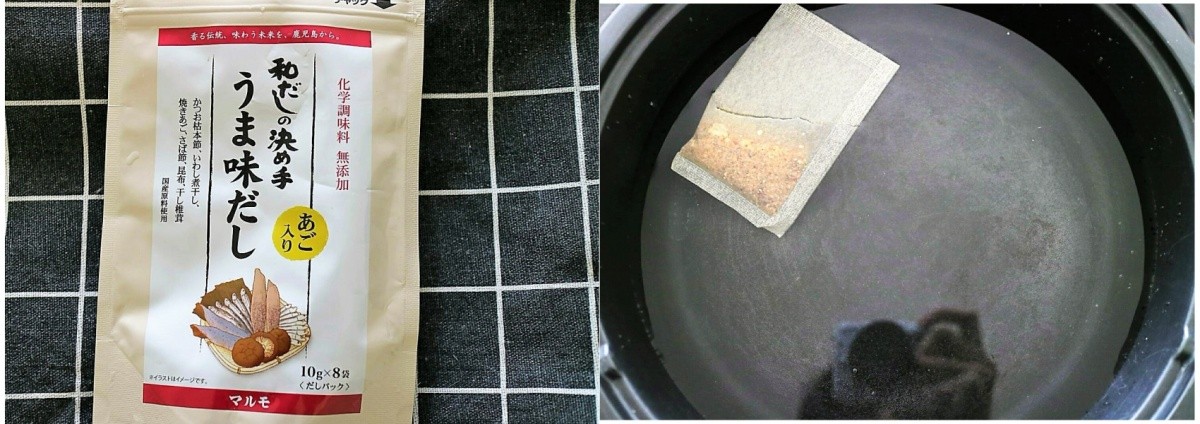
To enjoy the original flavor of the Japanese Wagyu, the shabu-shabu stock should as simple as possible so that it won’t take away the fresh and sweet flavor of the premium meat products. The stock I choose for this shabu-shabu is a bonito stock pack from Kagoshima. It has zero chemical additives, and has been very popular in Japan for quite some time. The pack only needs to be boiled briefly, and you’ll soon have a delicious sea tangle and dried fish stock. This is a very convenient and practical solution for individuals that don’t have time to make stocks.
Japanese shabu-shabu don’t have cabbage!?
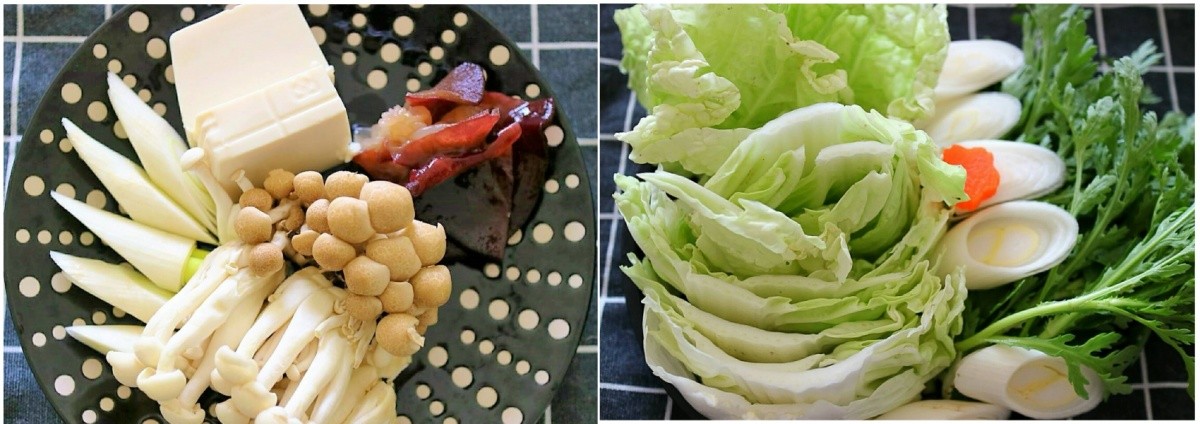
With the premium Wagyu slices and stock in place, fresh vegetables are definitely needed to compliment the shabu-shabu. Taiwanese people enjoy eating dumplings with their shabu-shabu, but the Japanese mostly eat mushrooms and vegetables with their shabu-shabu as they don’t need to be washed and can be cooked directly. The extremely low-calorie beach mushrooms and oyster mushrooms are essential ingredients to Japanese shabu-shabu. High-fiber ingredients for a low-calorie diet such as tender tofu, green onions are often found in Japanese shabu-shabu as well. As for vegetables, the Japanese are used to using napa cabbages to enhance the sweet taste of the stock. In addition, the mountain chrysanthemum, which is much firmer than the Taiwanese chrysanthemum, is also an essential vegetable for Japanese shabu-shabu.
One slice at a time! Enjoy the taste of the thinly-sliced Japanese Wagyu
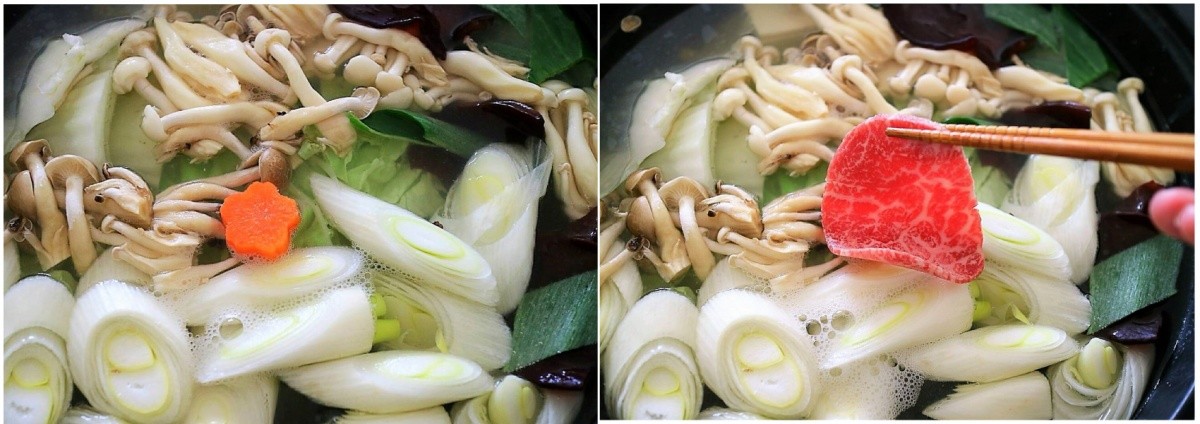
People first eat the meat and then the vegetables when they have proper Japanese shabu-shabu. However, all of the vegetables and mushrooms have been boiled in the stock first before blanching the meat as a means to accommodate the Taiwanese shabu-shabu dining habits. The Japanese Wagyu slices should be gently blanched with one slice at a time. After the Wagyu slice has been dipped and blanched in the boiling stock for a couple times, the Wagyu slice is ready to be sampled when it has a pinkish-red color to go along with the white-colored fat. It is crucial to not blanch the entire plate of Wagyu slices as the scum will not only ruin the stock, the flavor of premium Japanese Wagyu is wasted away as well.
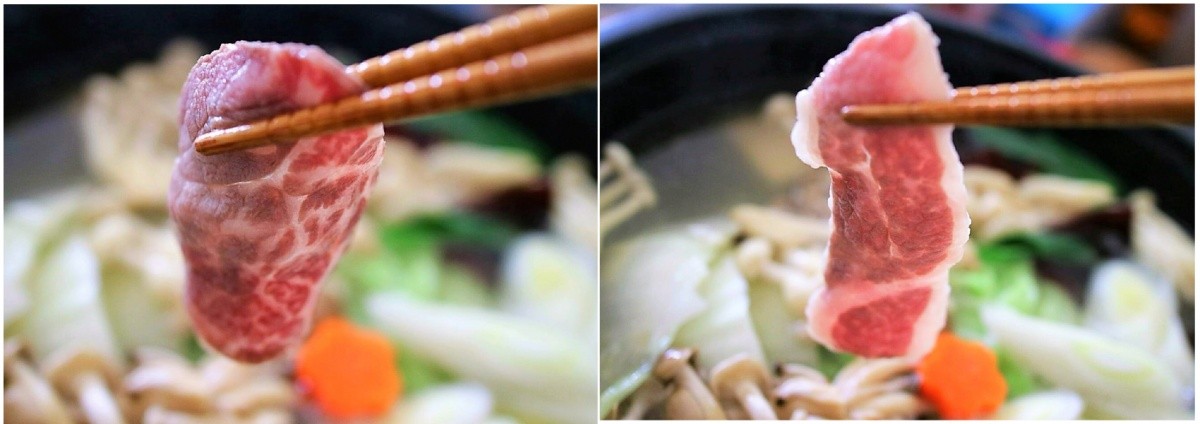
The Japanese Wagyu strip loin slices (Left) only need to be briefly blanched to see its distinct marbling, and there’s no other way to describe the texture other than that it instantly melts in your mouth! The thin-cut short rib Wagyu slices (Right) are a bit firmer and thicker than the strip loin slices, but still maintain a tender texture when sampled. So how should it be sampled? I recommend that everyone begin with sampling the original flavor of the Japanese Wagyu! Everyone should taste the gravy and sweetness with the tips of their tongues as that is the only way to enjoy the original flavor of Japanese Wagyu!
Major Differences in Taiwanese and Japanese Sauces
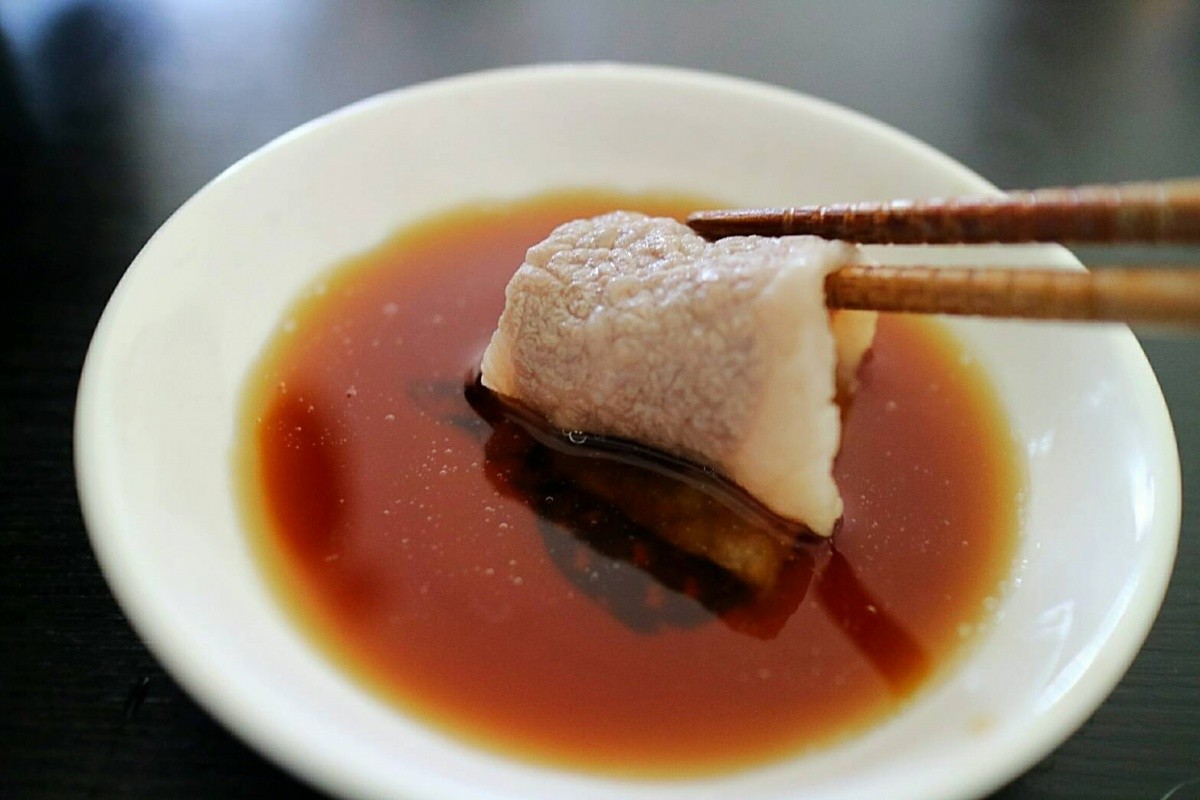
Taiwanese people are used to having shacha sauce, but the Japanese are more accustomed to their citrus vinegar sauce. Not only does the refreshing citrus vinegar sauce not take anything away from the Japanese Wagyu, the sauce itself is a great compliment to the low-calorie and richly-marbled Japanese Wagyu. Sauces suitable for Japanese Wagyu shabu-shabu can be found at a DAISO Life Coordinate Shop, or at fancier Japanese supermarkets. It can also be created by evenly mixing Japanese soy sauce and mirin, and a few drops of lime to easily create a delicious and refreshing sauce for a Japanese Wagyu shabu-shabu at home!
How should the remaining stock be used?
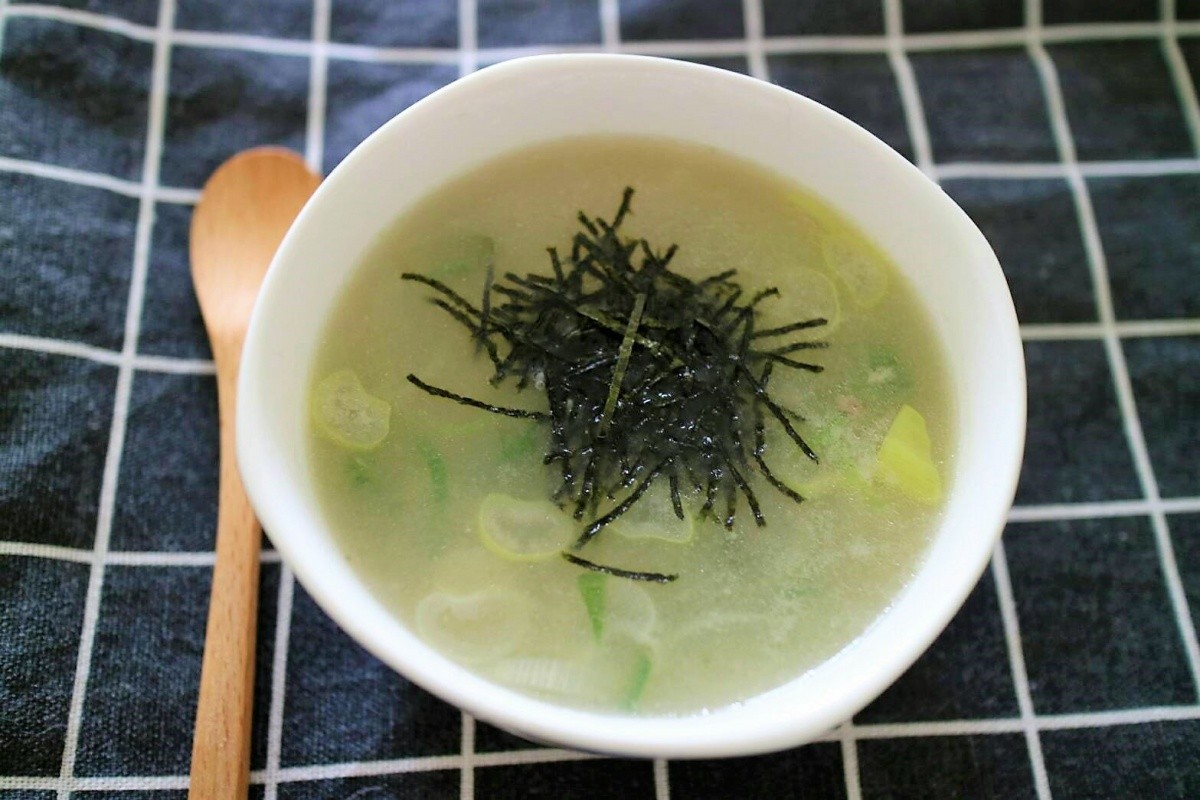
I would like to conclude by talking about the dining cultures of Japan and Taiwan. While most Taiwanese people are accustomed to eating rice with the shabu-shabu, the Japanese usually eat their carbohydrates after finishing the contents of the shabu-shabu. Using this time’s Japanese Wagyu shabu-shabu as an example, the Japanese believe that the best finishing dish is having rice, udon noodles or ramen noodles cooked in the stock. This is done after the stock that has been enriched by the essences of the sweet vegetables and the thin-cut Japanese Wagyu slices. It is topped off with a cracked egg and chopped green onions to complete the recipe. Even though Taiwanese people do not have such a dining habit, I still won’t let this enriched stock go to waste. Therefore, I will keep the stock until the following morning and an egg to cook a bowl of porridge with the soup. It’s an easy and resourceful meal that employs the shabu-shabu’s enriched stock.
Effortlessly cook this recipe at home! The Simple and Delicious thin-cut Japanese Wagyu Shabu-shabu
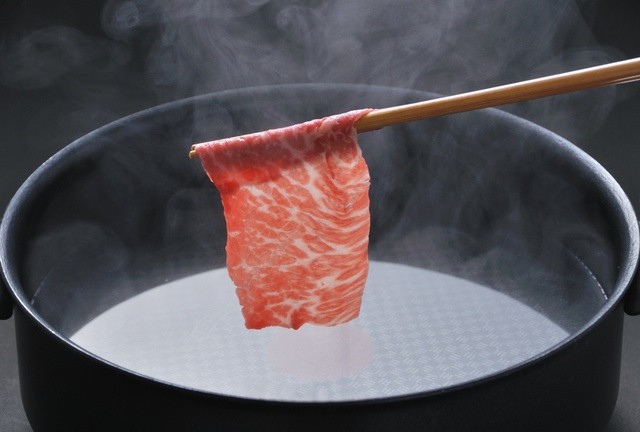
Do you also want to enjoy the delicious and tasty Japanese Wagyu on low-calorie and low-budget basis? I’m sure that this proper Japanese Wagyu shabu-shabu recipe that has combined Taiwanese dining habits is a great solution for foodies looking to control their body weight! The refreshing stock, mellow sauce and plentiful vegetables all enhance the sweet and fresh taste of the Japanese Wagyu. You’d better start cooking right now if you want to be free of guilt and sample the ultra delicious premium Japanese Wagyu!
Extended Reading: Super Easy and Guaranteed Success! Easily cook up 2 innovative Japanese Wagyu recipes at home
https://allabout-japan.com/zh-tw/article/6355/
1st Recommended Japanese Wagyu Recipe: Broiled Japanese Wagyu Sushi Roll
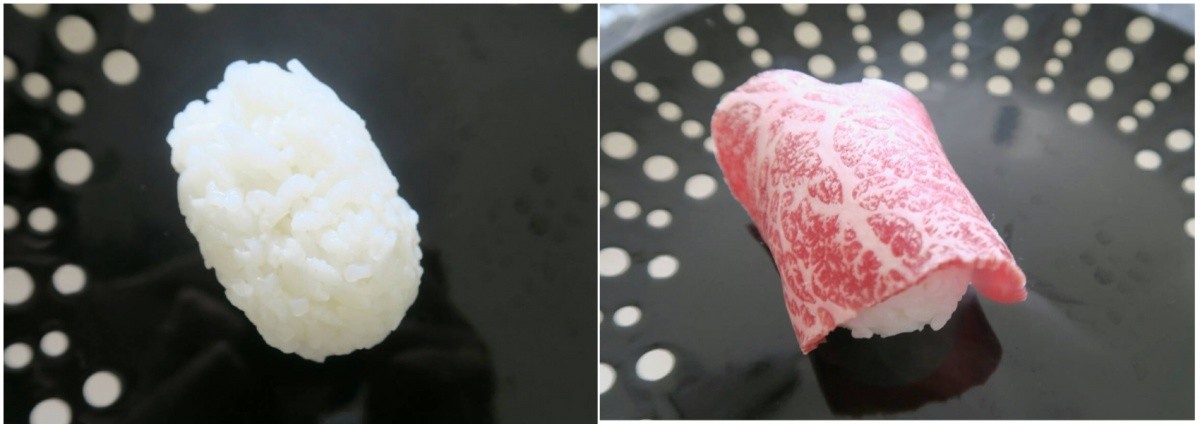
As I laid eyes on the A5 Japanese Wagyu that was purchased online, I immediately thought of using the beautifully-marbled striploin to make broiled sushi rolls. The first step is to evenly mix 1 tablespoon of sugar and white vinegar, and then pour it onto cooked rice. A rice ladle is then used to evenly churn and create the sushi-meshi. Have your hands rinsed with water and pinch the cooked rice into a serving enough for one mouthful, and place a slice of Japanese Wagyu that defrosted in room temperature onto the sushi-meshi.
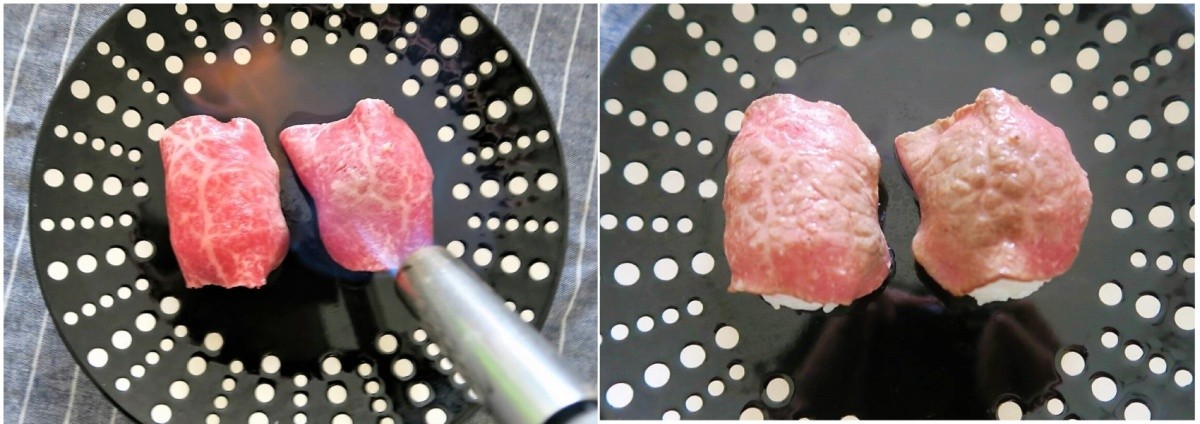
Use the culinary torch to directly broil the surface of the Japanese Wagyu slice. Wagyu is best sampled when the surface turns into a pinkish-white color! People that are hesitant in eating overly-raw food can broil Wagyu slices for a longer period of time to get the gradation they desire.
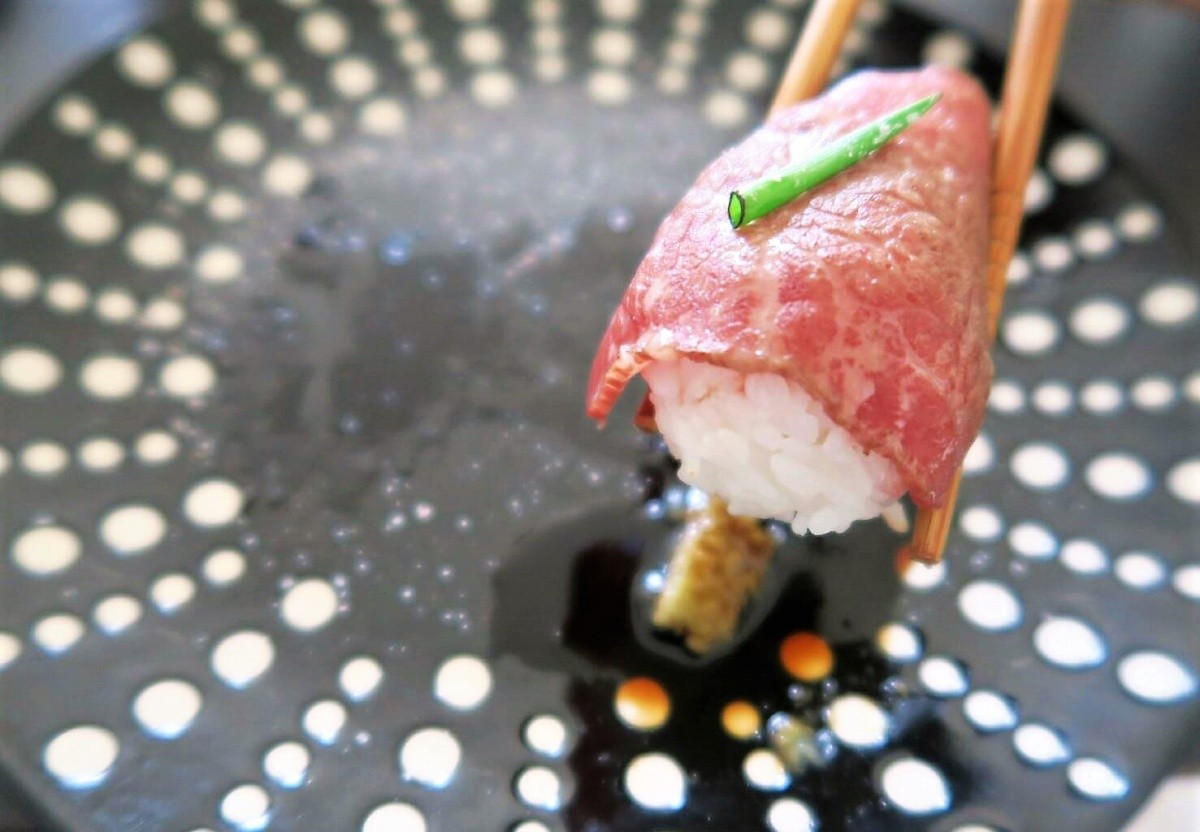
Those that want to sample the sweet and delicious Japanese Wagyu can try sprinkling some sea salt onto the broiled Japanese Wagyu sushi roll, or slightly dip it into some wasabi and soy sauce as they highly recommended ways to enjoying the sushi roll!
* Thoughtful Reminder: To prevent food poisoning, please remember to ask the seller if that Japanese Wagyu product can be eaten raw!
2nd Recommended Japanese Wagyu Recipe: Beef Soup with Sweet Ginger and Radish Puree
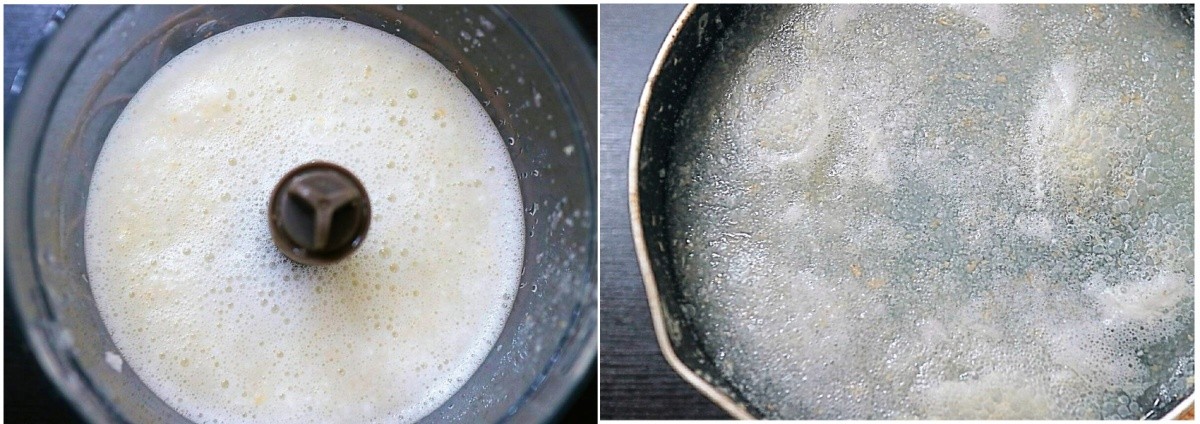
I would like to introduce the second recipe: beef soup with sweet ginger and radish puree. In order to unleash the sweet taste and aroma of the Japanese Wagyu, I chose to imitate the Tainan room-temperature Beef Soup recipe by pouring the boiled sweet ginger and radish puree onto the thin-cut Japanese Wagyu. A hint of salt finally completes the bowl of beef soup, and people can sample a soup that features the sweet and tender texture of Japanese Wagyu. The first step is to cut up a small piece of ginger and half a bowl of small Chinese radish fragments. The next step is create a puree from these two ingredients using a bowl of water and a food processor or blender. After adding the puree to a pot, add two more bowls of water to boil the puree.
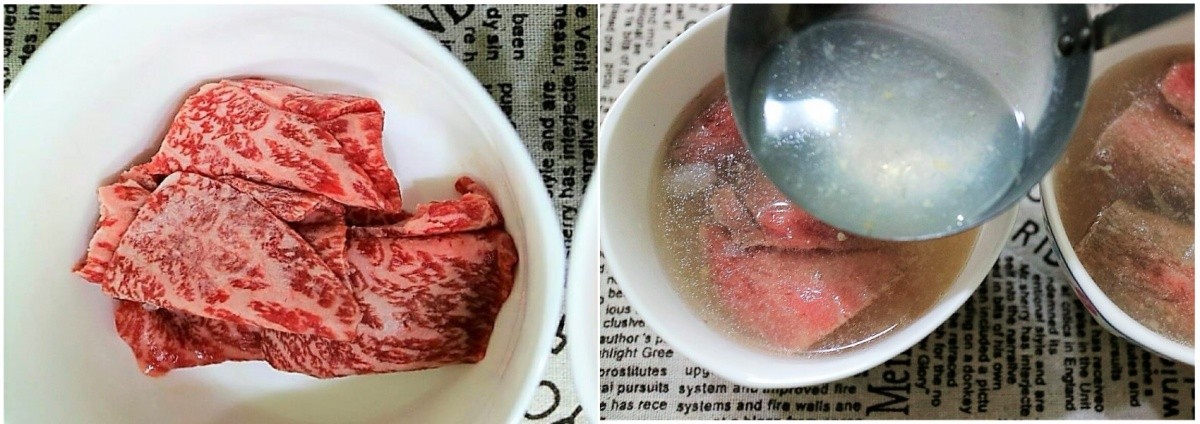
Follow up by placing 2 to 3 thin-cut Wagyu slices into the soup bowl, and boldly pour the boiling broth that features sweet ginger and radish puree onto the Wagyu slices.
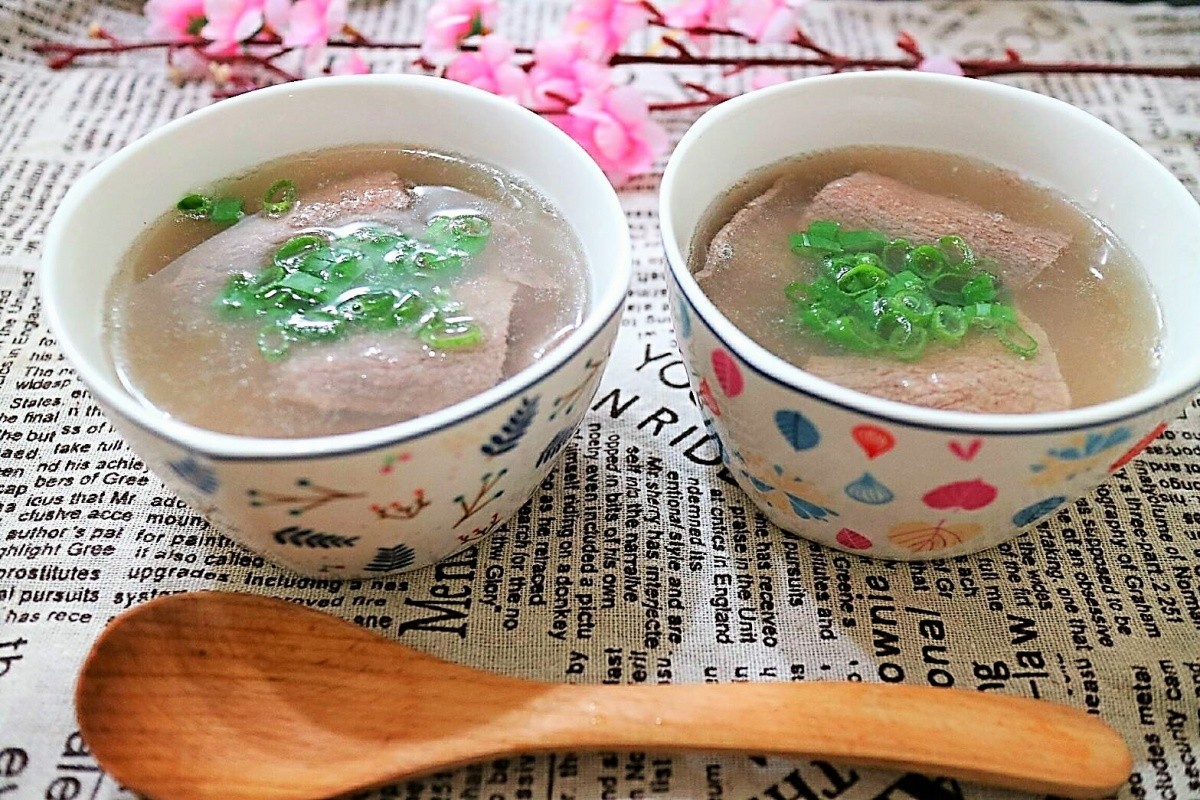
Allow the Wagyu slices that have been drenched in boiling broth to sit for 1 to 2 minutes, and sprinkle a hint of salt after the pink Wagyu slices have gradually become white. Finish the recipe by adding some chopped green onions, creating a simple and sweet Beef Soup with Wagyu slices, sweet ginger and radish puree! This soup is incredibly easy to make and can be enjoyed during the winter or make people feel better when they have a cold. The tender aroma and marbling of Japanese Wagyu is fully blended into the soup. Individuals that have no appetite have no problem finishing an entire bowl of this delicious soup.
How do you select Japanese Wagyu? Just look for the Beef Japan Mark!
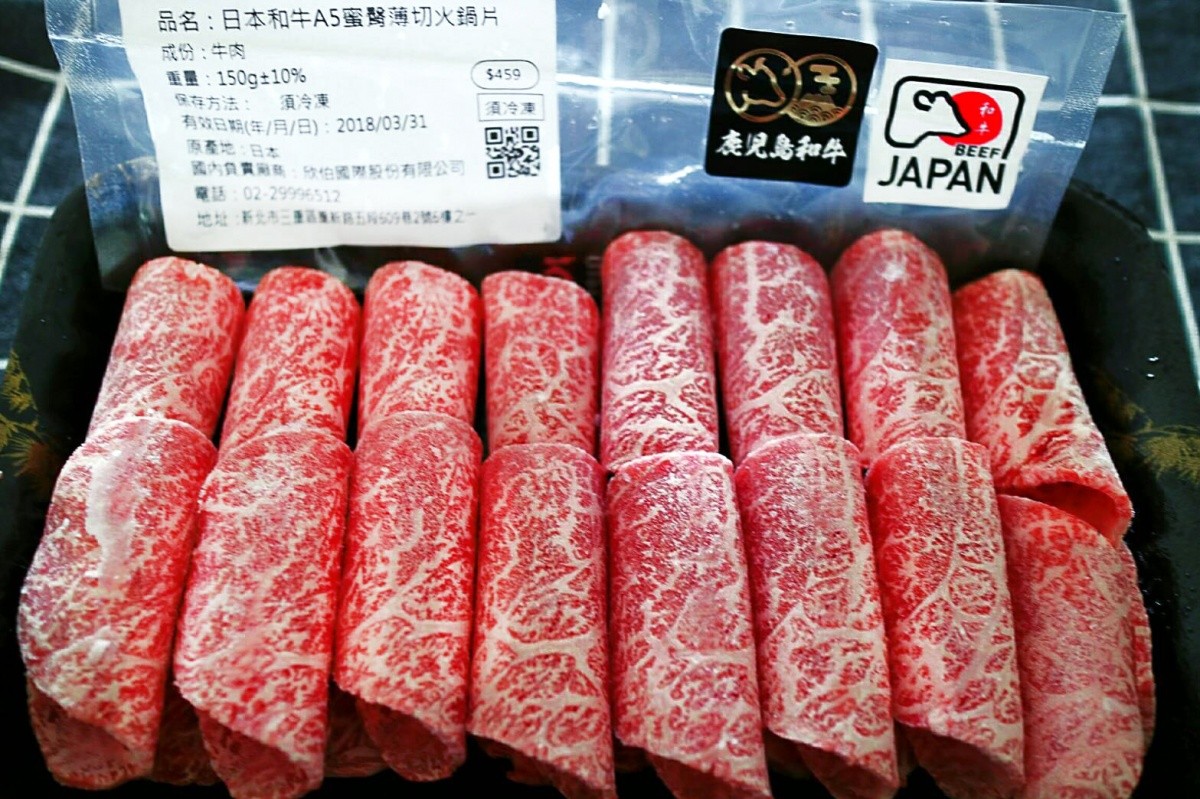
I’ll conclude by talking about which websites I used to purchase the Japanese Wagyu! In order for me to utilize Japanese Wagyu’s aroma from the marbling, tender texture, delicate flavor and enjoy in a short amount of time, I chose to purchase A5 Japanese Wagyu (120g for NT$ 369) on Keeper’s Sense’s online store. This budget-friendly and simple recipe surely can be cooked up at home in a short amount of time even if they have zero cooking fundamentals! Even if you don't have time to have a meal at a restaurant and just want to sample Japanese Wagyu at home, you can purchase officially-certified Japanese Wagyu at these websites. These Japanese Wagyu products with the Beef Japan Marks on them will allow you to have a Japanese Wagyu feast at home whenever you desire!
・Keeper’s Sense (Small packaging with every box priced at between NT$ 300-500, a suitable purchase for small families)
https://goo.gl/nkwvpE
・Mayfull Fine Foods (Offers original cuts and pre-cut Japanese Wagyu steaks, the price or pre-cut steaks are price at around NT$ 3,000)
https://goo.gl/H2ygzu
・JUYI Wagyu (Offers various premium A5-grade Japanese Wagyu, and special cuts for barbeques such as the hanger steak. Prices start at NT$ 600)
https://goo.gl/pwj3TW
★ Please refer to the following website for more information on purchasing Japanese Wagyu:
https://wagyu-jfoodo.jetro.go.jp/
Integrating Japanese dietary culture into the trend of dining on Japanese Wagyu
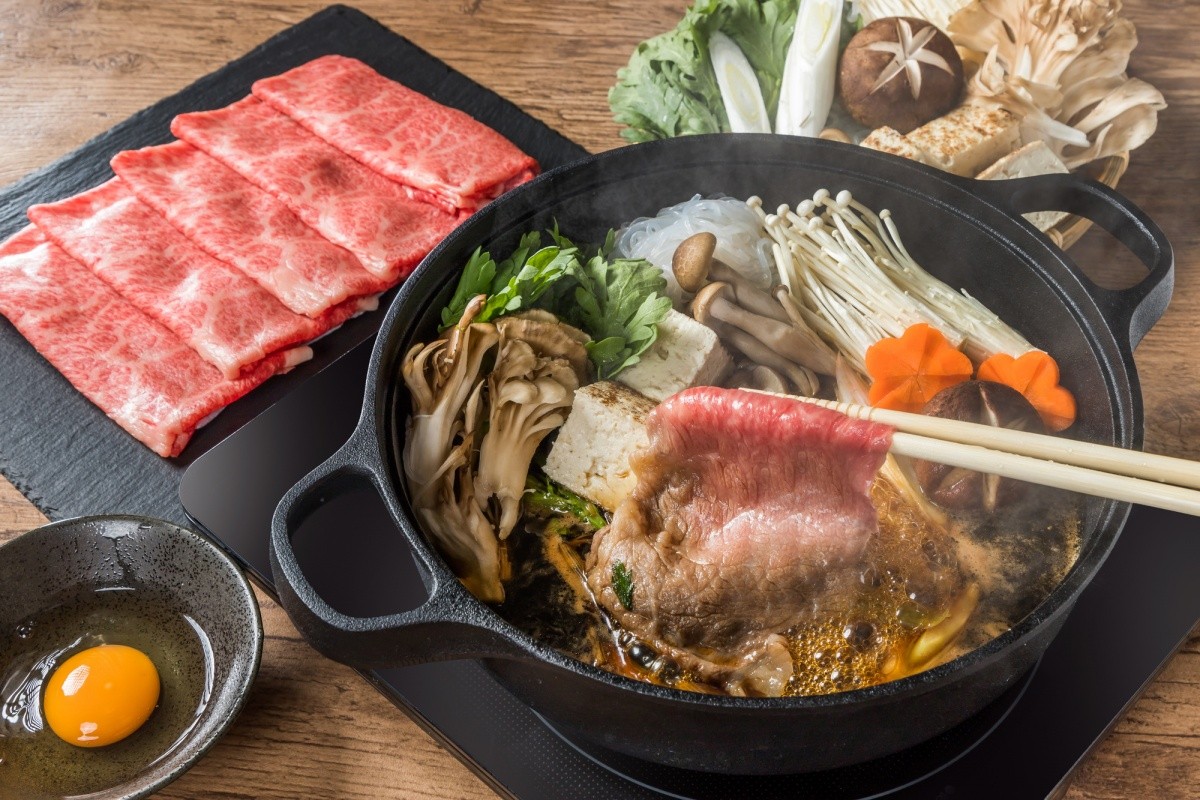
An expert from the Japanese Wagyu Olympics pointed out that sukiyaki is one of the best ways to sample the Japanese Wagyu.
Japanese cattle have traditionally been used for plowing fields, but the habit of consuming meat products became gradually prevalent after the Meiji period (1868 A.D.). Even though Kyoto completely preserved its traditional culture in the 1940s, the city has been very receptive of foreign cultures as well and is a city that represents the popular trends Japan. Kyoto has also been responsible for making sukiyaki popular for eating beef products.
Sukiyaki can be regarded as an important element throughout the development of Japanese Wagyu Culture. The marbling of thin-cut Wagyu slices melt away at just the right temperature (approximately 80℃), bringing out the sweetness and aroma of Japanese Wagyu. The sukiyaki exhibits the two delicious qualities of Japanese Wagyu: the way it melts away in peoples’ mouths, and how it smells and tastes like peaches and pineapples. Japanese Wagyu and sukiyaki have become popular and deeply rooted into the dietary culture of Japan.
The Attentive and Sincere Spirit of the Professional Breeder
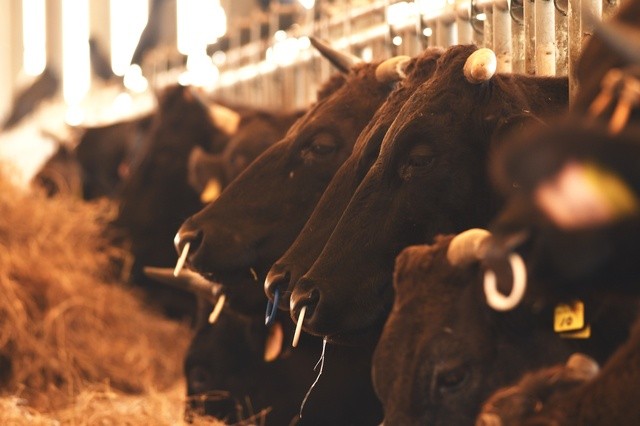
Wholehearted Care is why the Japanese Wagyu is placed at the Top
The specifications for breeding Japanese Wagyu cattle are unimaginably high. From the moment they are born, the calves require a proof of their pedigree, hoof prints, and naming as proof of their identity. The calves must be separated from their mothers and are specially fed with artificial milk. In addition, the breeders need to pay attention to changes in temperature all the time and even have to put on special jackets for them when the weather gets cold.
Calves that are approximately 7 to 10 months old are known as “koushi (also known as motoushi),” and breeding farms will publicly auction these koushi to professional fattening farms. The Wagyu cattle will only be sold after the breeders go out of their way to breed them until they weigh 700kg. The primary food of Wagyu cattle is basically composed of hay, straw and Whole Crop Silage (WSC), which is often used in animal agriculture. The straw is an essential ingredient that contributes to the white marbling of Japanese Wagyu. In addition, fattening farms also employ their secret recipes to breeding the cattle. The breeders’ persistence and attention to their cattle is evident as they put in a lot of effort and emotions into them. There is no doubt that the devotion of the breeders is crucial to the delicious taste of Japanese Wagyu.
Branding and a strict Wagyu Grading System
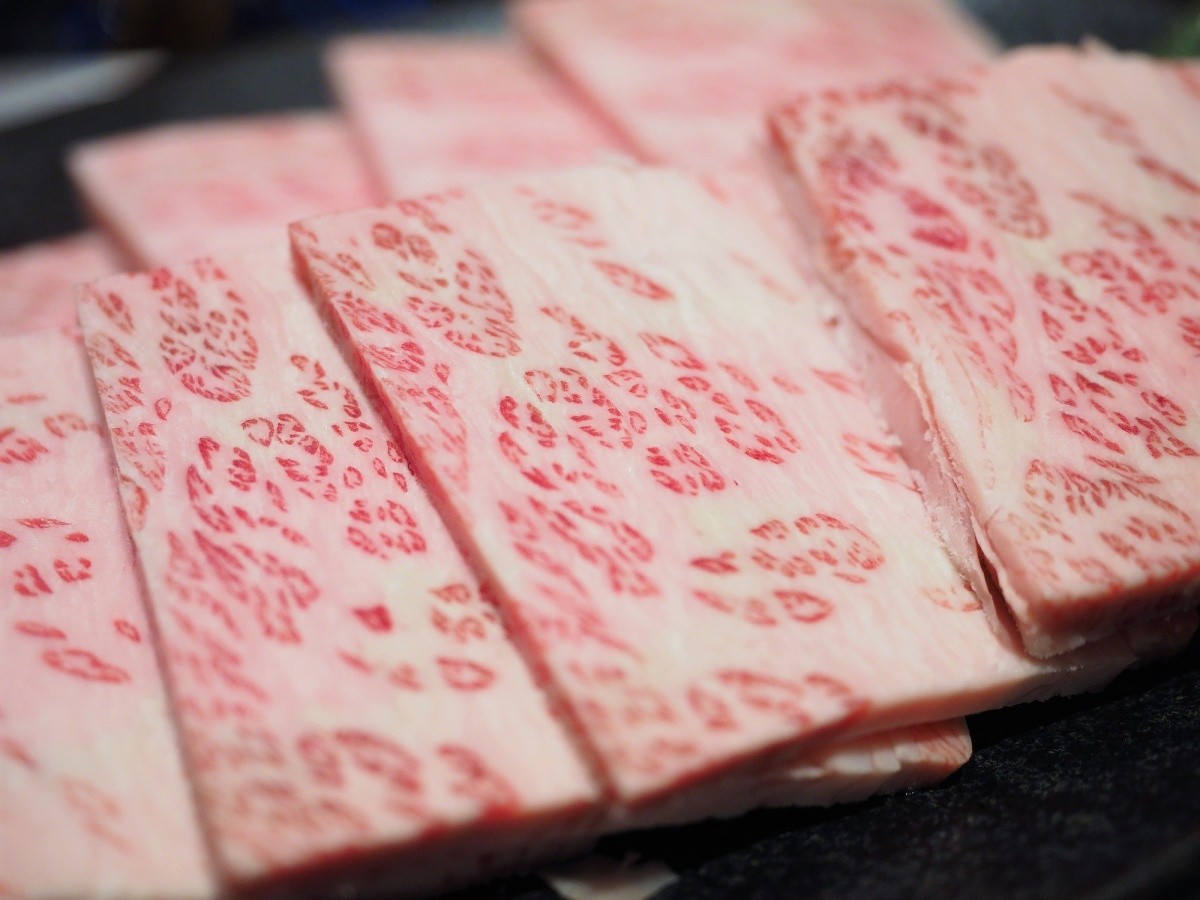
Apart from the care and breeding process of these cattle, the Japanese Wagyu market also has its own brands called Meigaras. The three major Japanese Wagyu brands that most people are familiar with: Kobe beef, Matsusaka beef, and Omi beef are all certified brands that have gone through strict inspections at various places. These 150-odd “Meigaras,” such as Miyazaki beef, Yonezawa beef, and Hida beef have all been inspected and certified using the same process. Wagyu products that carry the name of their origins are priced higher than basic Japanese Wagyu products.

Japanese Wagyu Grading Chart
The grading for Japanese Wagyu, known as “Kakuzuke” in Japanese, has three grades of A, B, and C based on “First Pass Yield (FPY, also known as “Preliminary Yield, refers to the ratio of edible red meat) with A being the highest grades. The color, texture and marbling between the six and seventh rib section are graded from 1 to 5 with 5 being the highest grade. 15 grades are created from these two categories (A5, A4... all the way down to C1). This is the origin and meaning the “A5 Wagyu” that we often see on the market today. Other countries have their own grading system as well: Australia’s official grading system categorizes beef products from M1 to M9 with M9 being the highest, which is equivalent to an A3 Japanese Wagyu. However, Australia has refined its Wagyu breeding techniques and added M10 to M12 grades to its grading system with the M12 being mostly equivalent to the A5 Japanese Wagyu.
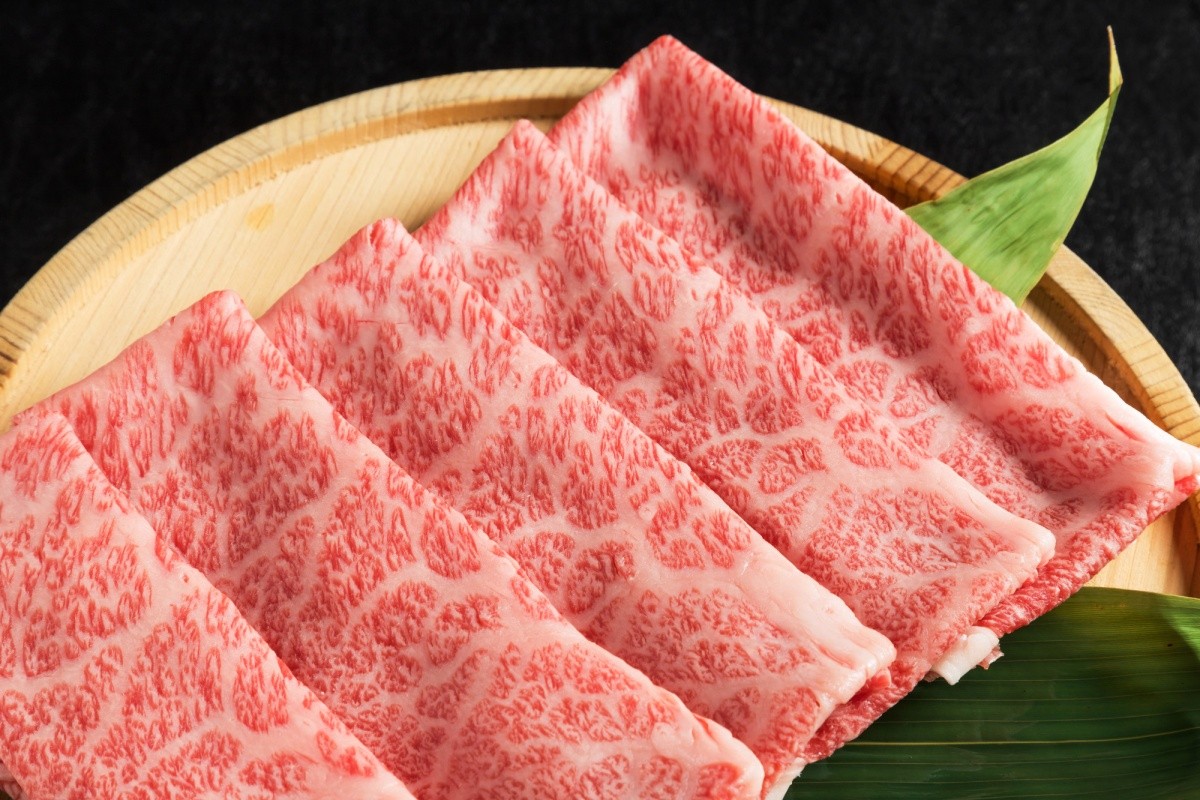
But does A5 Japanese Wagyu guarantee the best taste? This depends on personal preference. The key factors contributing to Wagyu’s grade are the marblinga nd the amount of fat. Wagyu with a level 5 grade have the best marbling, but may not satisfy connoisseurs that enjoy chewing on firmer meat instead of Wagyu that melts in their mouths. People are only capable of correctly selecting Wagyu products that match their personal preferences after they learn in detail about the culture of the Wagyu brands, Wagyu grading system, texture characteristics, and suitable recipes for the Japanese Wagyu.
Learn in detail about Japanese Wagyu culture, and discover suitable Japanese Wagyu dishes
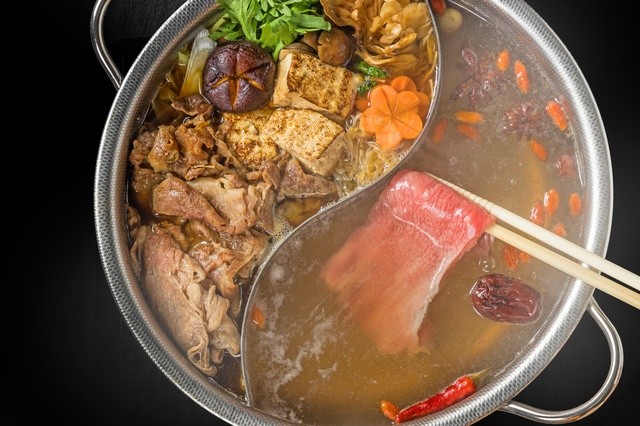
Washoku, Wafuku (kimono), Wagashi are items that all represent the persistence in attention to detail that is found in Japanese Culture. The Wagyu, which also shares the root “Wa,” is no exception to this. The spirit of Japanese professionals is deeply rooted into Wagyu culture: it begins with the tracking of calves’ pedigrees once they’re born, to the attentive care given to the cattle by the breeders, and is concluded with the establishment of private brands and grading system. The following contributions are the reasons why western countries cannot resist the charm and delicious taste of the Japanese Wagyu despite having a longer history of having beef in their meals.
Is the Wagyu a breed that is 100% native of Japan?
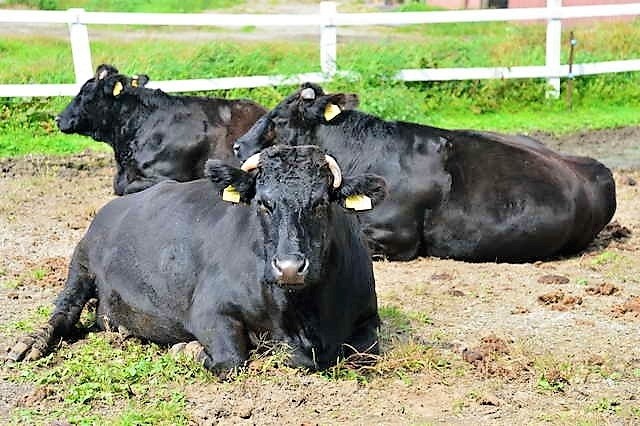
Japanese breeders allow the cattle to graze to ensure that the cattle remain healthy throughout the breeding process.
Many believe that Wagyu is a cattle breed only found in Japan, but this statement is not entirely correct. The Wagyu cattle were originally raised in the rich and fertile nature of Japan as work cattle for plowing rice fields, and innately possess beautiful marbling. The term “marbling,” which originated from the Japanese Wagyu, describes the snow-white webs of fat on top of the red meat, just like a marble wall or floor.
In ancient Japan, the cattle were indispensable farm animals and Shintoism restricted people from eating meat. However, as Japanese civilization flourished during the Meiji Period (around 1887 A.D.), many places caught on with the trend of modifying cattle breeds. The perfect Wagyu breed was finally created after attempting to crossbreed with foreign cattle and numerous modifications. It can be deduced that Japanese Wagyu combines the best qualities of the local Japanese cattle with foreign cattle breeds to create a premium level food ingredient.
Look at Wagyu’s earliest ancestors from the “Ten National Cattle”

Left: The Original “Ten National Cattle” / Right: The appearance of the Royal Cattle
Humanity has a long history of relying on cattle as farm animals. Japanese records indicate that cows were domesticated and introduced to Japan at roughly around 400 B.C. Painted scrolls from the Heian period (794 A.D. - 1185 A.D.) depicted members of royalty or nobility riding on highly-decorated oxcarts. The “Ten National Cattle” from the Kamakura Period recorded the physical traits of the native Japanese cattle breeds (10 listed breeds, 1 breed was lost). The Hyogo, the ancestor of the immensely popular Wagyu, is one of the ten breeds. The remaining breeds of cattle include the Tsukushigyu, Mikuriyagyu, Awajigyu, Tanbagyu, Yamatoushi, Kawachigyu, Tootoumigyu, Echizengyu, and Echigogyu.
A Miracle from Numerous Modifications: The Tajirigo
The Tajirigo, which is the ancestor of the Japanese Black, is the most important key to the developmental history of Japanese Wagyu.
The demand for beef increased due to Japanese civilization being introduced to the rest of the world and the popularization of edible beef. On the other hand, the breeding direction for cattle gradually shifted towards modifying them for eating purposes. Farming techniques were becoming more advanced and tillage machines became more popular, which reduced the cattle’s functionality as farm animals. A large variety of foreign cattle was introduce into Japan at that time for cross-breeding and modifications. The eventual product was based on the Hyogo, and bred into “The Tajirigo.” This was the deal edible cattle breed, and is the “ancestor” of the Japanese Black.
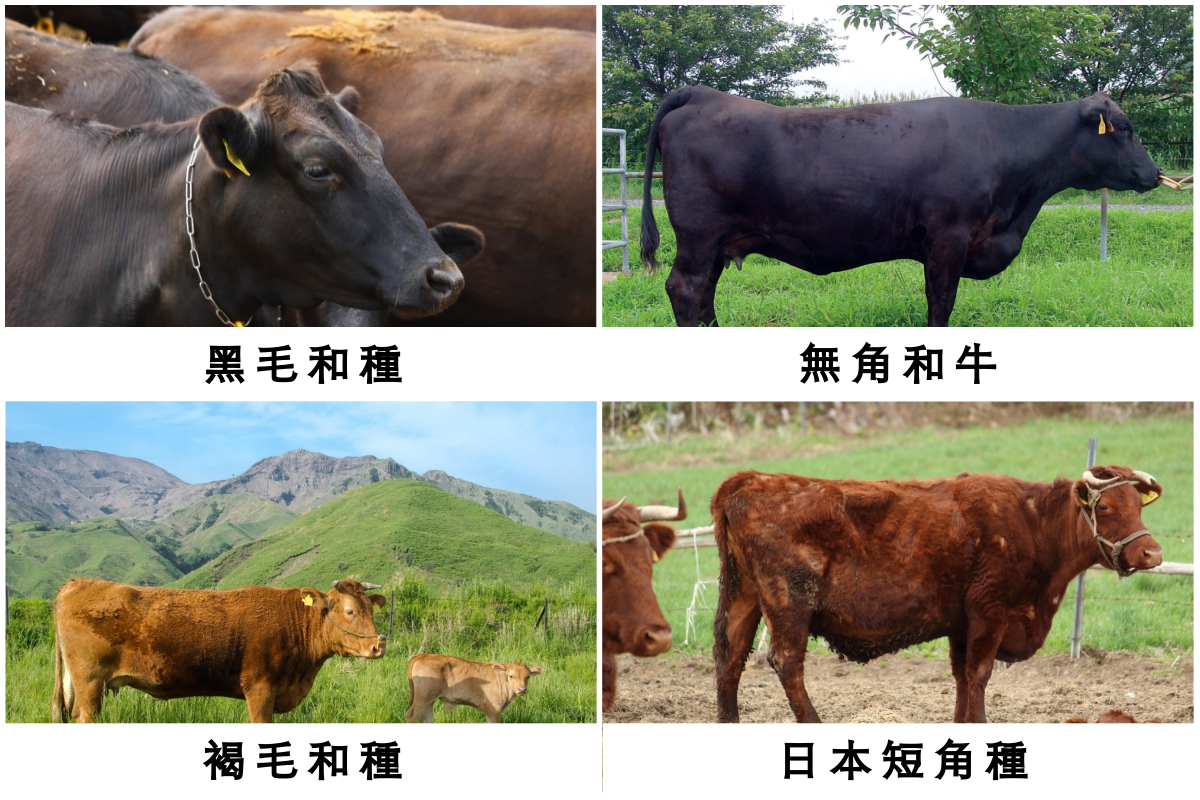
The evolution process has shaped four breeds of Japanese Wagyu: Japanese Black, Japanese Brown, Japanese Shorthorn, and Japanese Polled. Today, more than 90% of all fattened Wagyu cattle raised in Japan are Japanese Black (commonly known as "Black Wagyu").
Ensuring Purity of Pedigree with the Beef Japan Mark
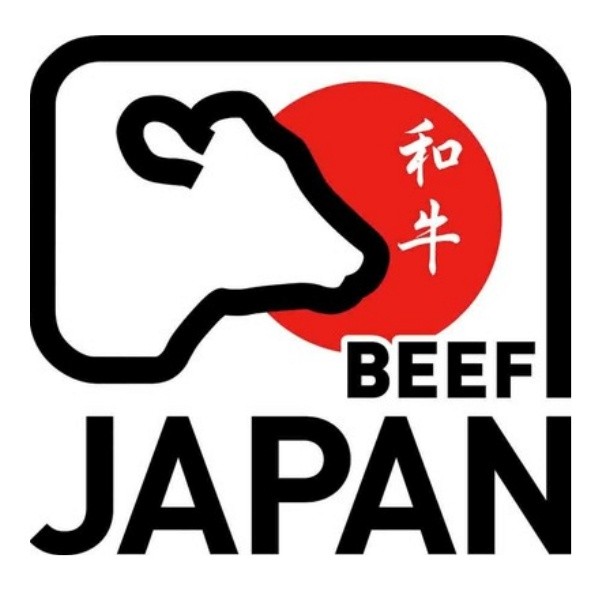
Japan strictly regulates the definition of “Japanese Wagyu,” as every cattle has its own birth certificate and pedigree record. The pedigree record includes the calf’s parents in detail to ensure purity of the pedigree. Currently, over 90% of the existing Japanese Black cattle are descendants from the Tajirigo bloodline. In 2007, Japan established the “Unified Japanese Wagyu Logo” to allow other countries to acquire proper knowledge about the Japanese Wagyu, and enable people from around the world to safely enjoy having true Japanese Wagyu.
Establishing the Irreplaceable Historic Value of Japanese Wagyu
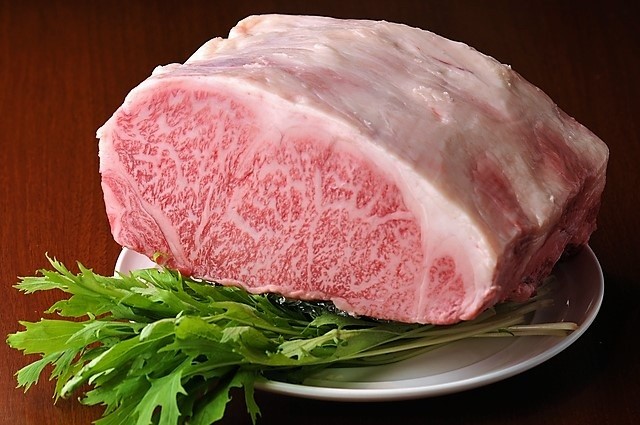
Even though Japanese Wagyu is priced higher than other breeds of imported cattle, Taiwanese people still flock to have a bite of the delicious and tasty Japanese Wagyu.
Upon examining the history of Japanese Wagyu, people would be surprised to find that “Syokugyu (eating beef)” isn’t a custom that is native to Japan. After Japan absorbed foreign cultures during the Meiji Period, they were able to fully localize those cultural elements and develop Japan’s very own “Wagyu” breed from western dietary cultures. Countries around the world that eat beef are amazed at the appropriately sweet aroma and unique marbling of Japanese Wagyu. The persistence and attention displayed by the Japanese breeders has made Japanese Wagyu irreplaceable in the Wagyu market.
The Varying Origins of the Japanese Shabu-shabu
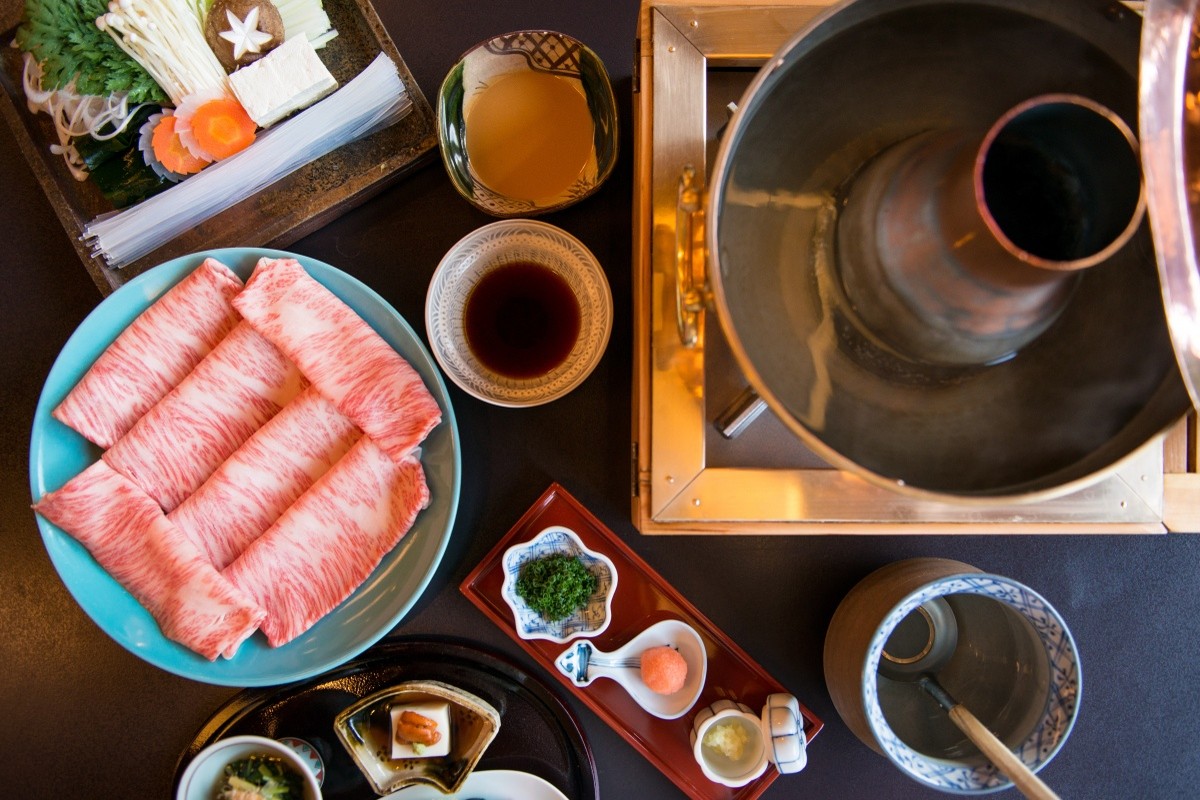
The shabu-shabu has always been one of Taiwanese peoples’ favorite foods. Unlike the plentiful Taiwanese shabu-shabu, the proper Japanese shabu-shabu is a work of art that pays attention to numerous aspects. It starts by directing attention towards the pots, ingredients, and sauces used for the shabu-shabu. There is plenty of meaning behind the order for eating the ingredients of the shabu-shabu as well. Taking the different eating habits out of the equation, nearly all of the Japanese people agree that he most common ingredient in a shabu-shabu is “beef.” Therefore, in high-end Japanese cuisine, Japanese shabu-shabu is a meal that is often used for receiving guests.
The origin of Japanese shabu-shabu is no longer traceable, but the archetype of the currently trending and proper Japanese shabu-shabu can be dated back to 1944. It was created by Mr. Shoya Yoshida, a medic who was stationed in Beijing, who used beef instead of Chinese blanched lamb and developed a sauce that was suitable for Japanese appetites. After many modifications and experiments, the copper pot was used as one of the ways to enjoy shabu-shabu since it had good thermal conduction.
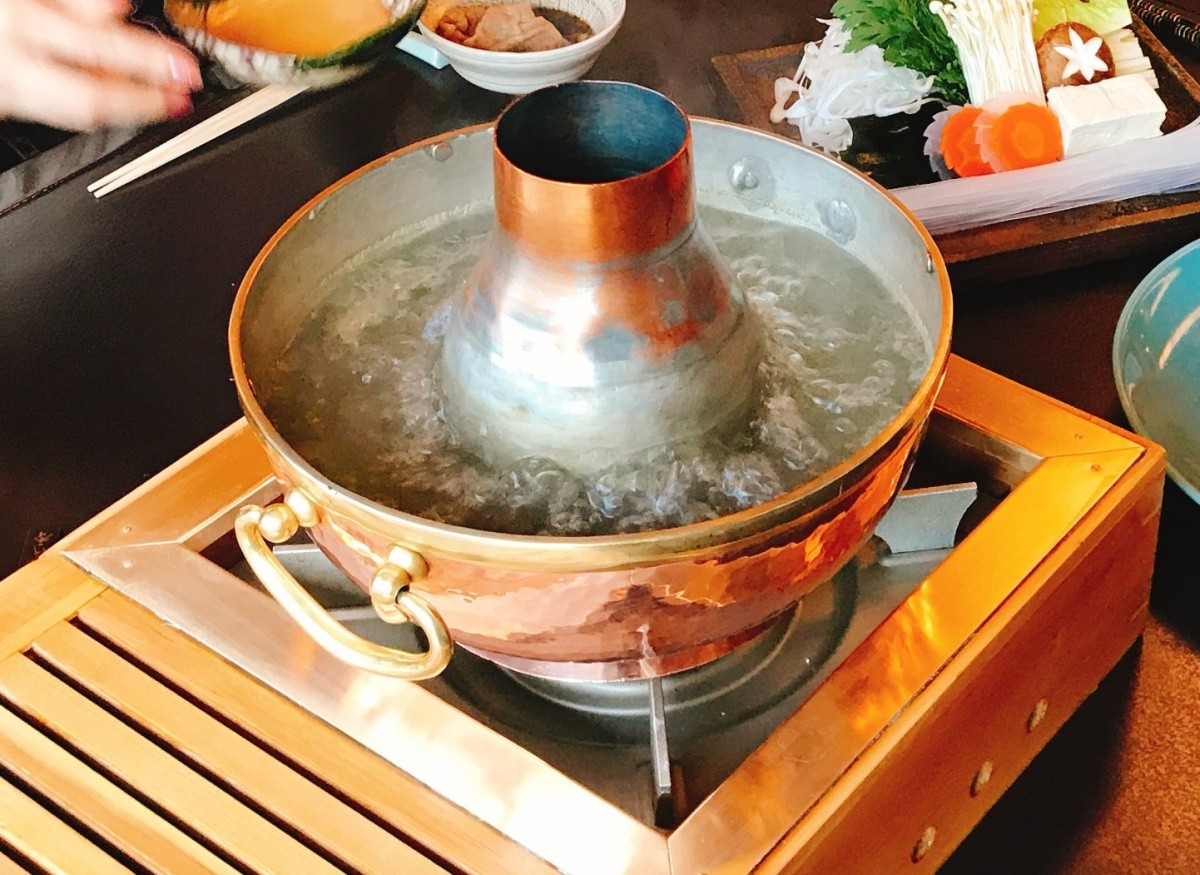
Attentive shabu-shabu shops use copper pots as they transfer heat at a faster rate.
The Essential Ingredients for Japanese Wagyu Shabu-shabu
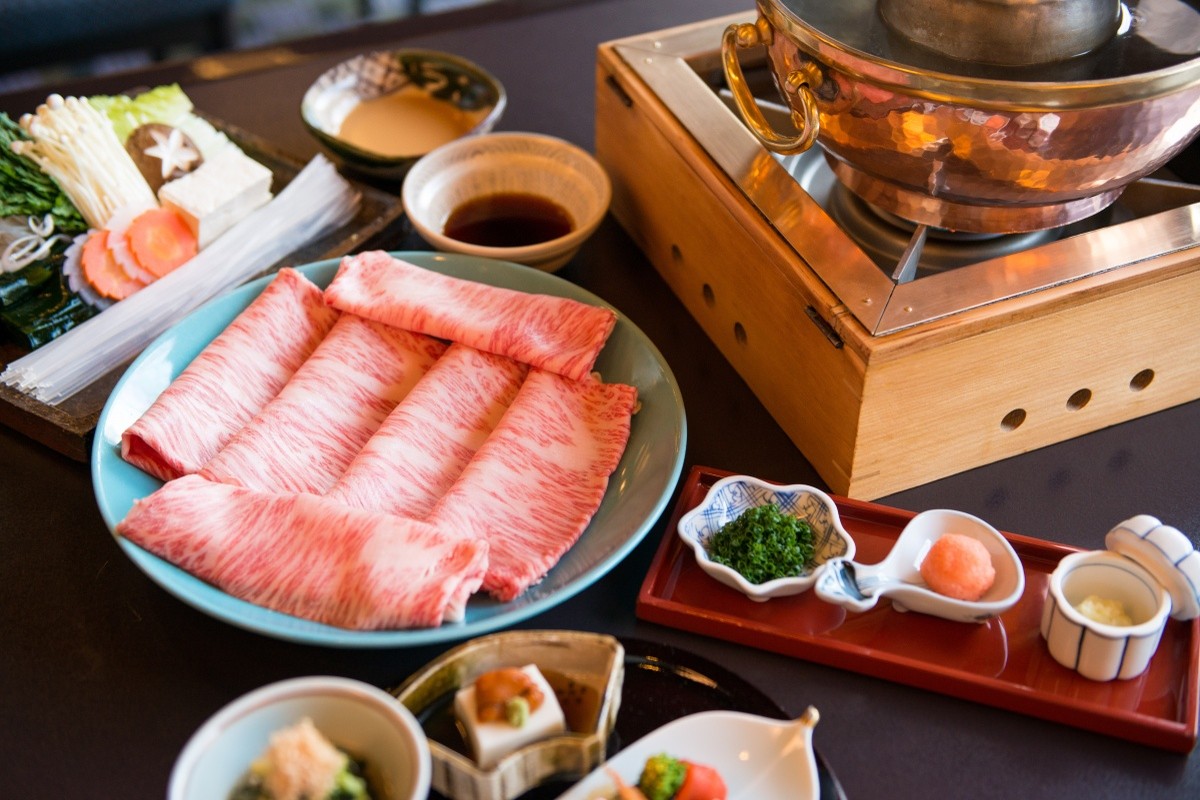
Before customers enjoy having their high-quality Wagyu shabu-shabu, most shops offer exquisite appetizers that differ due to varying menus. Every shop has different methods of plating and presenting “Japanese Wagyu” for shabu-shabu, but there are 2 main styles of presentation: the first being the plating of thin-cut slices and the second being the plating of folded slices. It is said that both plating styles do not affect the taste of Japanese Wagyu, but the author believes that the plating of the Wagyu slices is one of the factors that can influence customers’ appetites. There are two types of basic sauces that are tied closely to the blanched Japanese Wagyu Slices: the citrus vinegar sauce and sesame sauce Add seasoning such as chopped green onions, red radish puree (ground puree out of thick-cut Chinese radishes filled with red peppers), and garlic to make the shabu-shabu even more fascinating. The essential plate of vegetables has also changes from season to season, but primarily features edible root vegetables such as carrots and Chinese radish, leafy vegetables such as cabbage, Japanese mustard, and green onions. Japanese shabu-shabu uses various types of mushrooms and tofu as well.
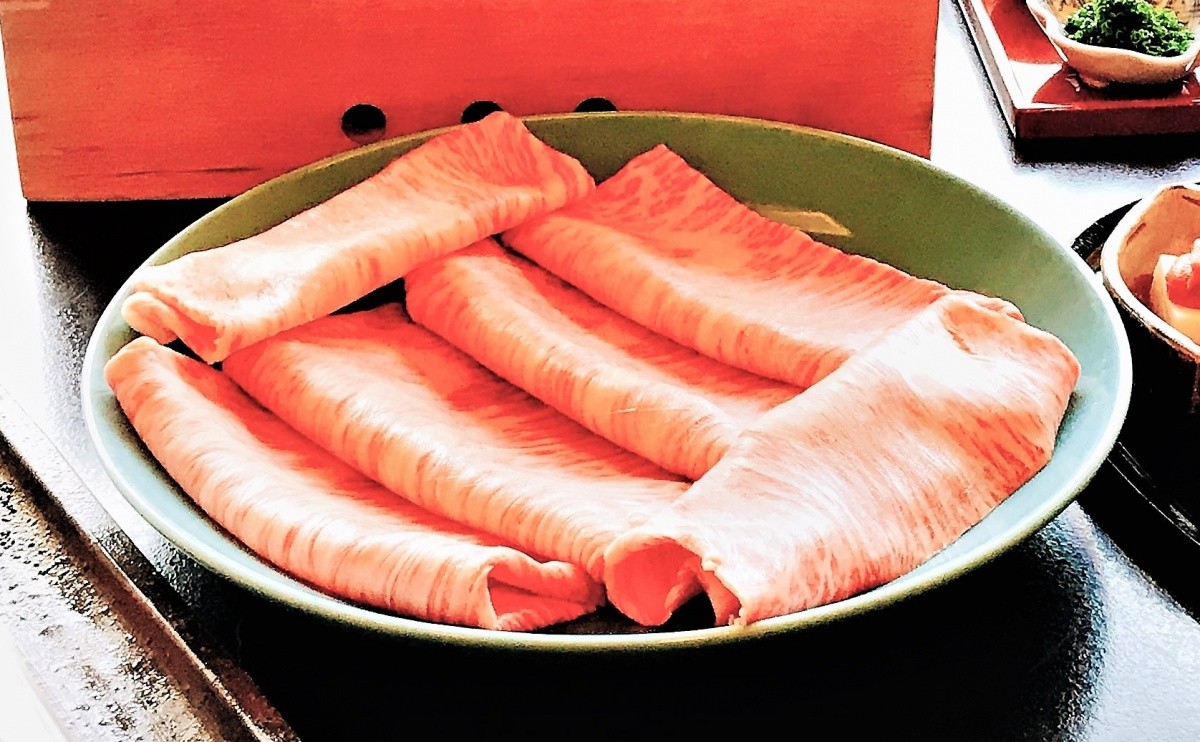
The thin-cut slices of the perfectly marbled Japanese Wagyu are definitely indispensable to the succulent and touching taste of the Japanese Wagyu shabu-shabu.
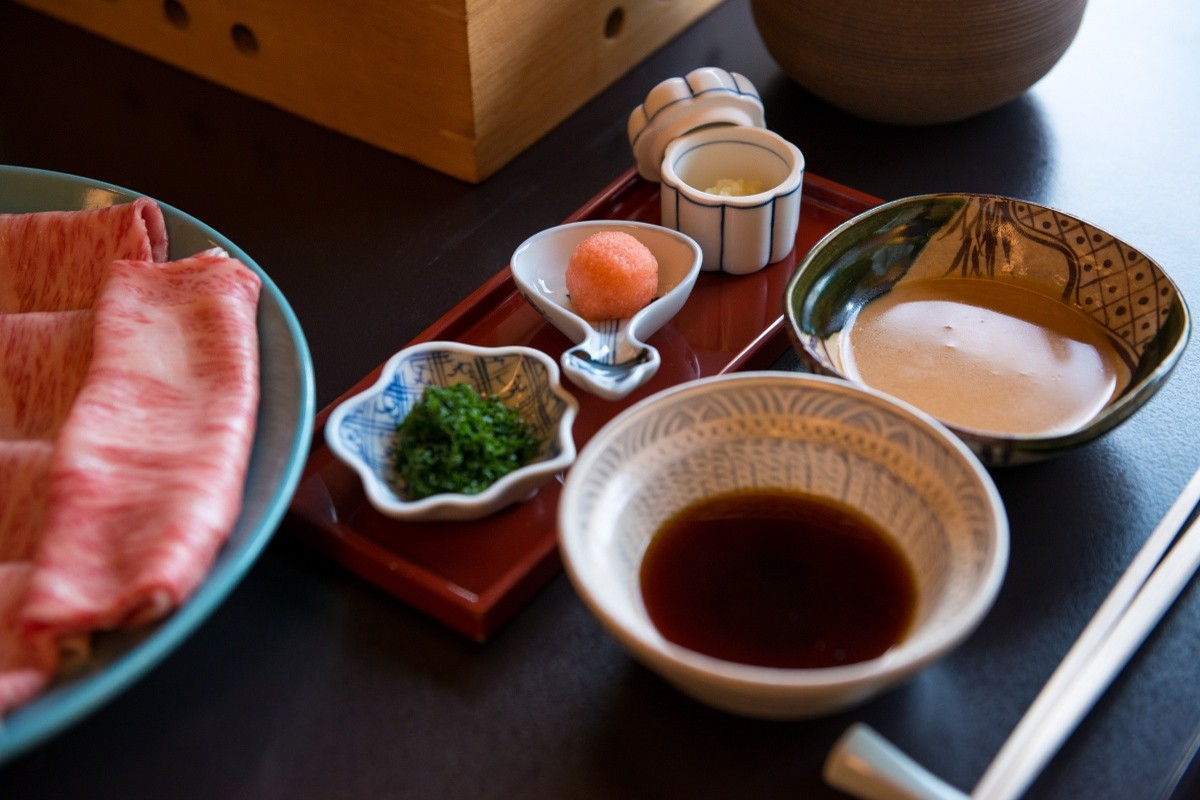
The citrus vinegar sauce (former) and the sesame sauce (latter). The sauces and seasoning from the left to right are: chopped green onions, red radish puree, and garlic puree.
The Proper way to have Japanese Shabu-shabu
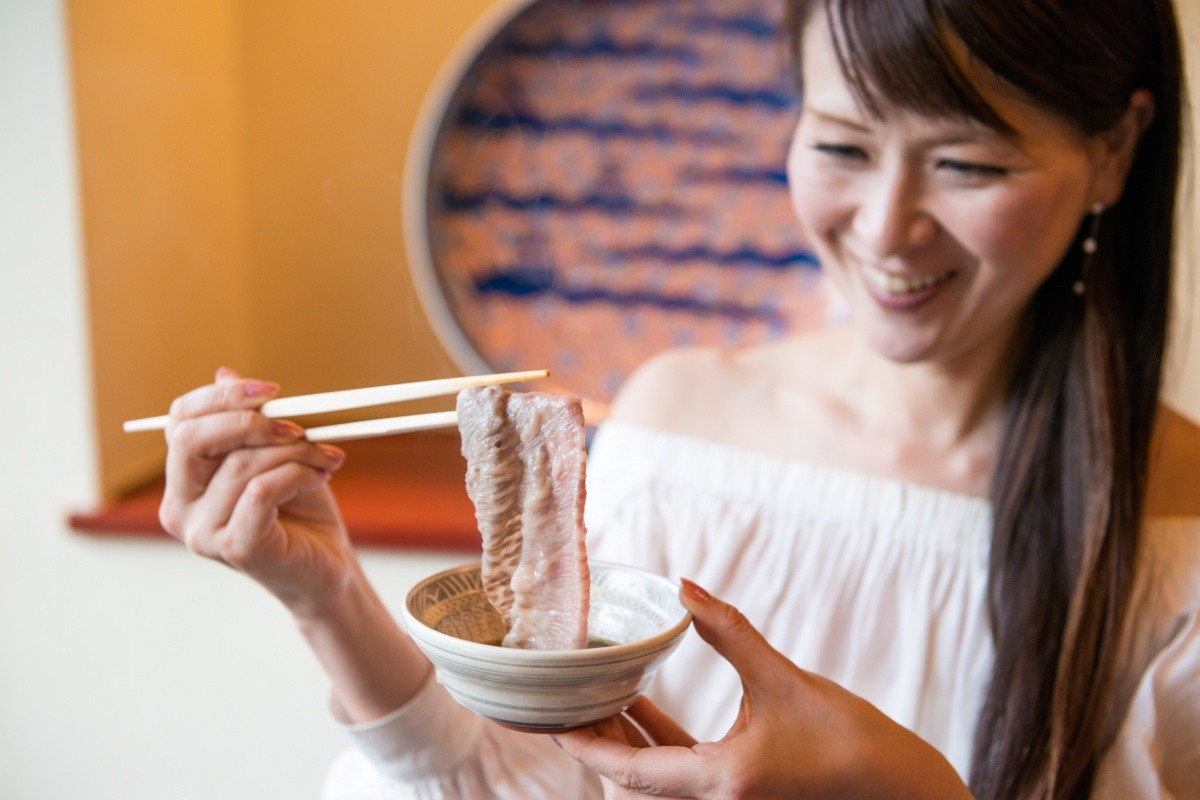
Fancier Japanese Wagyu shabu-shabu shops (average price above $JPY 10,000) usually have professional service staff to help blanch the Wagyu slices. However, if you are on a tight budget and still want to experience the original tastiness of the Japanese Wagyu, the author asked and compiled the “Basic Principles for Enjoying Japanese Shabu-shabu” from Japanese connoisseur Ms. Mayumi Satoi. As long as understand of these five key points, I believe that anyone can easily become a master of shabu-shabu at budget-friendly personal shabu-shabu or enjoy an occasional fancy meal at home.
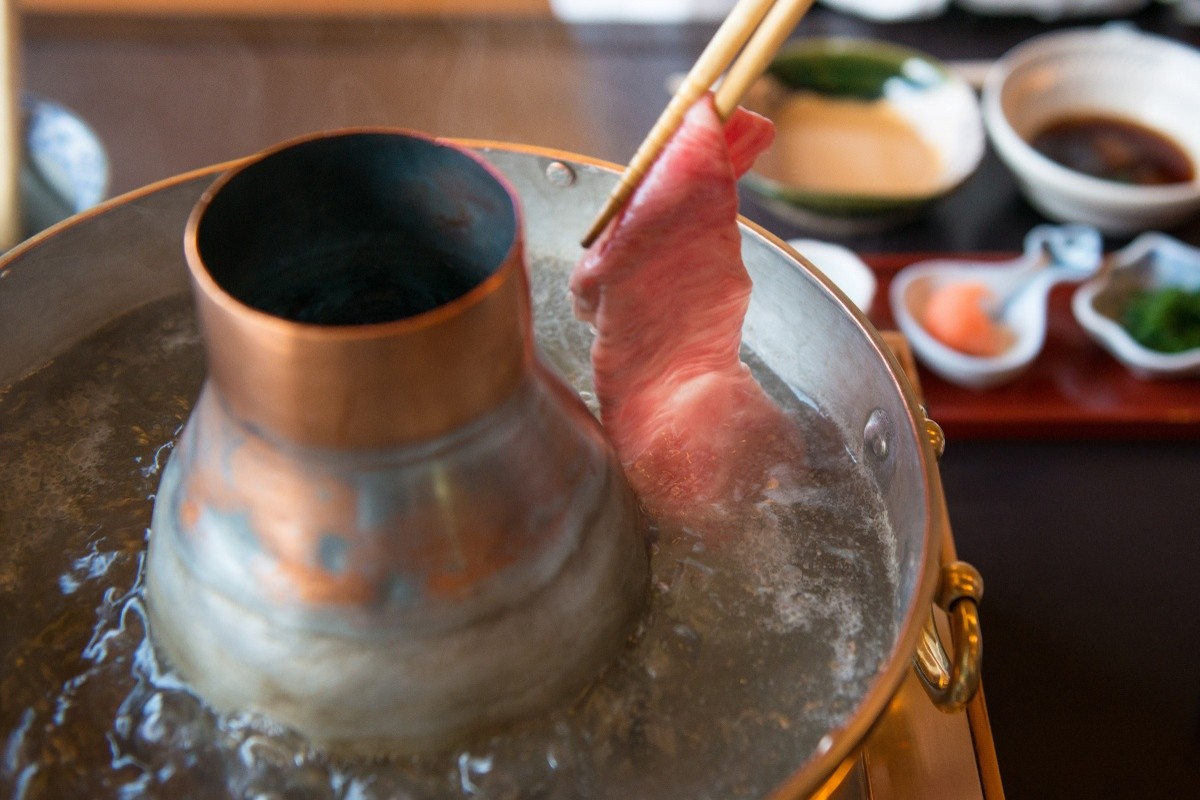
Key 1: Blanch the Wagyu Slices first, then eat the Vegetables
Use long chopsticks to lift the thin-cut Wagyu slices from the sides, and blanch them in boiling sea tangle broth. Blanch the Wagyu slices by swishing them back and forth inside the boiling broth three times (approximately 3 seconds, ※ can blanch the Wagyu slices for longer depending on personal preference), and Wagyu slices are ready to be enjoyed when they have a pinkish-white color. Gently blanching the Wagyu slices in the boiling broth removes parts of the Wagyu fat, which increases the sweet taste of the Japanese Wagyu. It is said that connoisseurs do not meticulously calculate the number of seconds anymore, and can eyeball when the Wagyu slices taste the best.
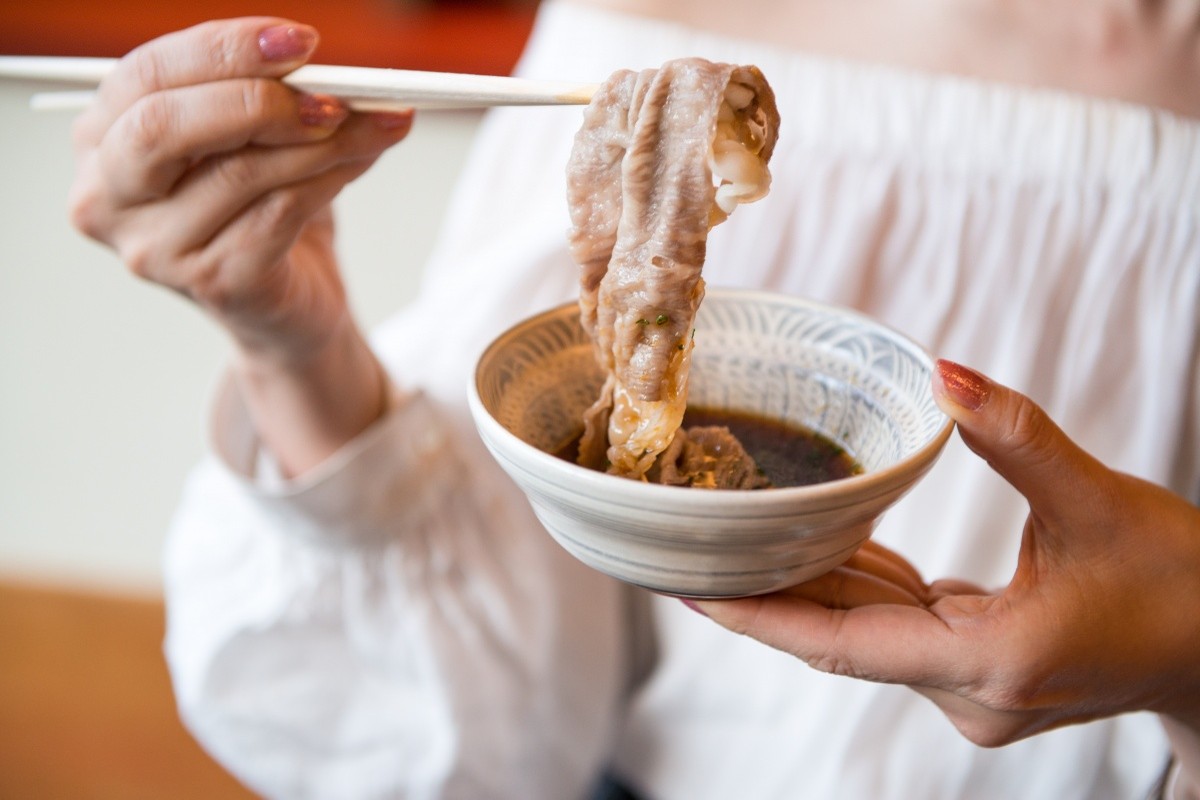
Key 2: Understand the Order of the Sauces
How should the first blanched slice of Wagyu be eaten? Japanese connoisseurs suggest that it is best to try the citrus vinegar sauce first since the sweet and sour taste of the refreshing sauce can bring out the gentle texture of the Wagyu, while also being capable of stimulating appetite. In addition, you can enjoy different layer of taste by trying the heavier-tasting sesame sauce after having their appetites stimulated by the first slice of Wagyu.
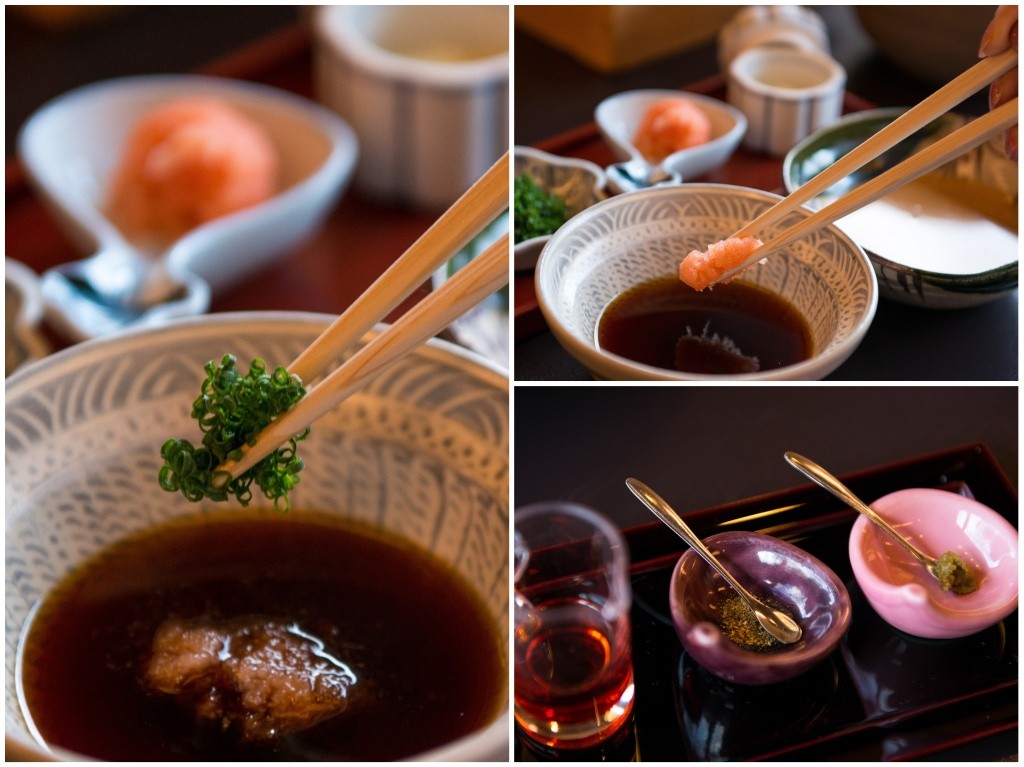
Chopped green onions, red radish puree, garlic puree and other basic seasoning can be added to the citrus vinegar sauce, which is a proper sauce for Japanese Wagyu shabu-shabu. It is said that a number of connoisseurs have recently started adding spicy oil, mountain pepper and Yuzu Kosho pepper to the base sauce.
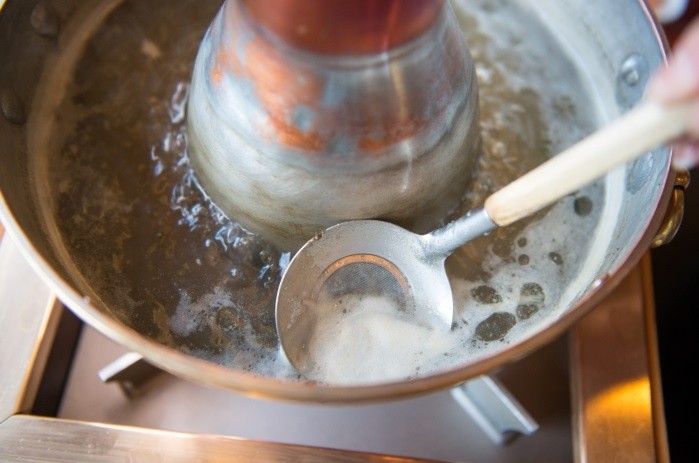
Key 3: Remove the Scum from the Broth
In addition to the excess fat in the broth, the protein released from blanched Wagyu slices and inosinic acid (which contains the scent of the Wagyu slices) form the scum that floats on top of the broth. You should use the filter spoon to remove the scum, and ensure that the entire pot of broth is in tip-top condition. Next, you can harmoniously combine the blanched vegetables with the sweet and delicious fat of high-quality “Japanese Wagyu,” subtly enriching the taste of the vegetables.
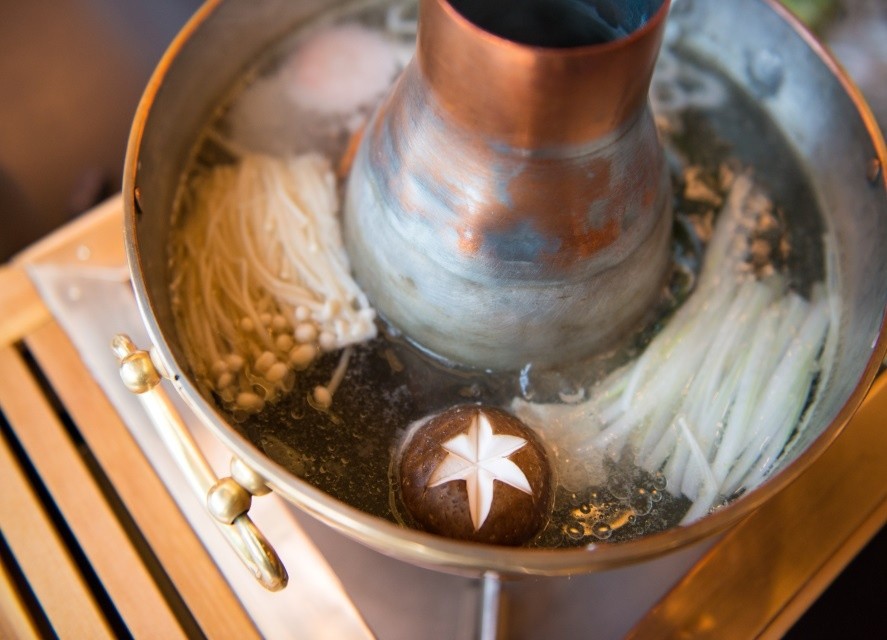
Key 4: The Order of the Vegetables
After understanding and mastering how to blanch and enjoy the Japanese Wagyu, people should not casually disregard the order and timing for blanching the vegetables. The root vegetables that is difficult to cook should blanched first, and the leafy vegetables should be blanched last.You can blanch them for a long or short as you like, and enjoy them with sauces after they have floated to the top of the broth. As mentioned above, the broth-boiled vegetables can absorb the essences of the gently blanched Wagyu slices. People instantly fall in love with the juicy and sweet taste of the vegetables.
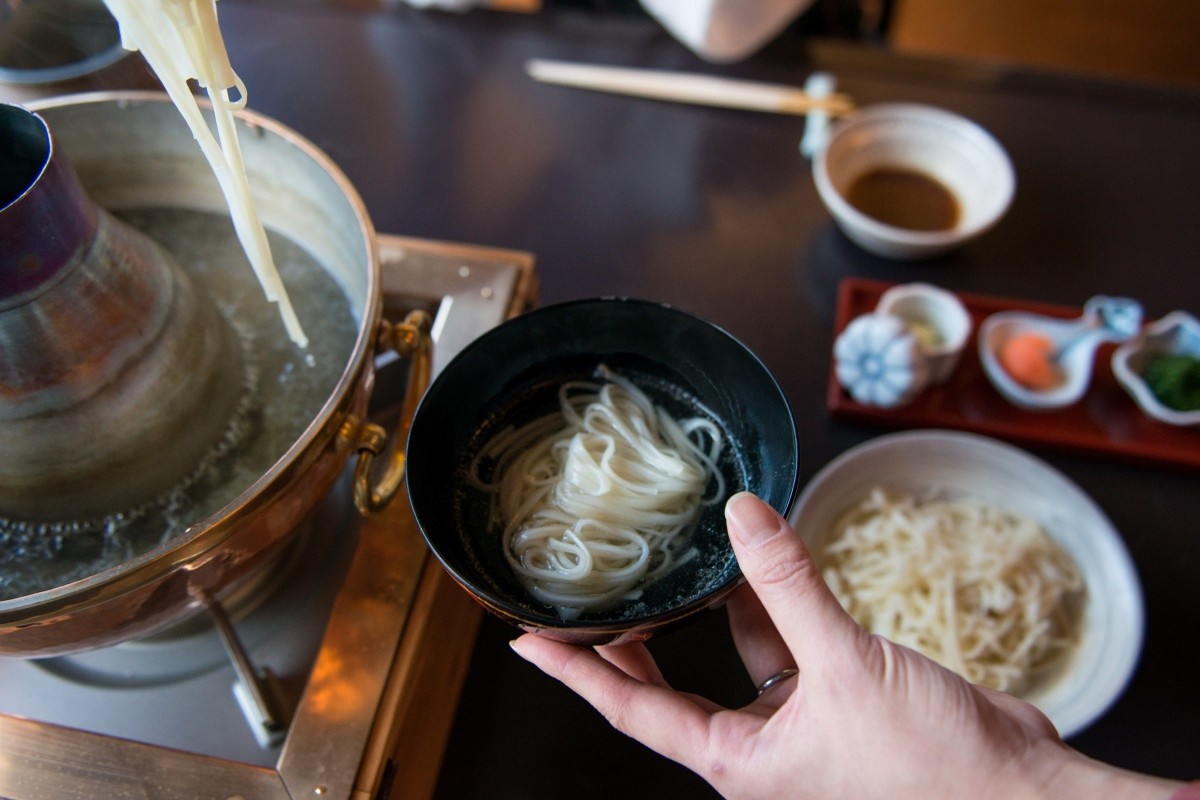
Key 5: Finishing Dishes
After eating all of the Wagyu slices first or eating them with the vegetables, you can’t miss out on the proper Japanese Wagyu shabu-shabu broth that contains essences from all kinds of ingredients. You should add udon noodles, rice or boil an egg into the remaining broth to make some chowder. Japanese people believe that the chowder, seasoned with some salt and pepper, is the best finishing dish after eating the ingredients of the shabu-shabu. The light dish is also the conclusion to a perfect meal.
Conclusion: Master the Keys to enjoying Proper Japanese Shabu-shabu for the Best Gourmet Experience
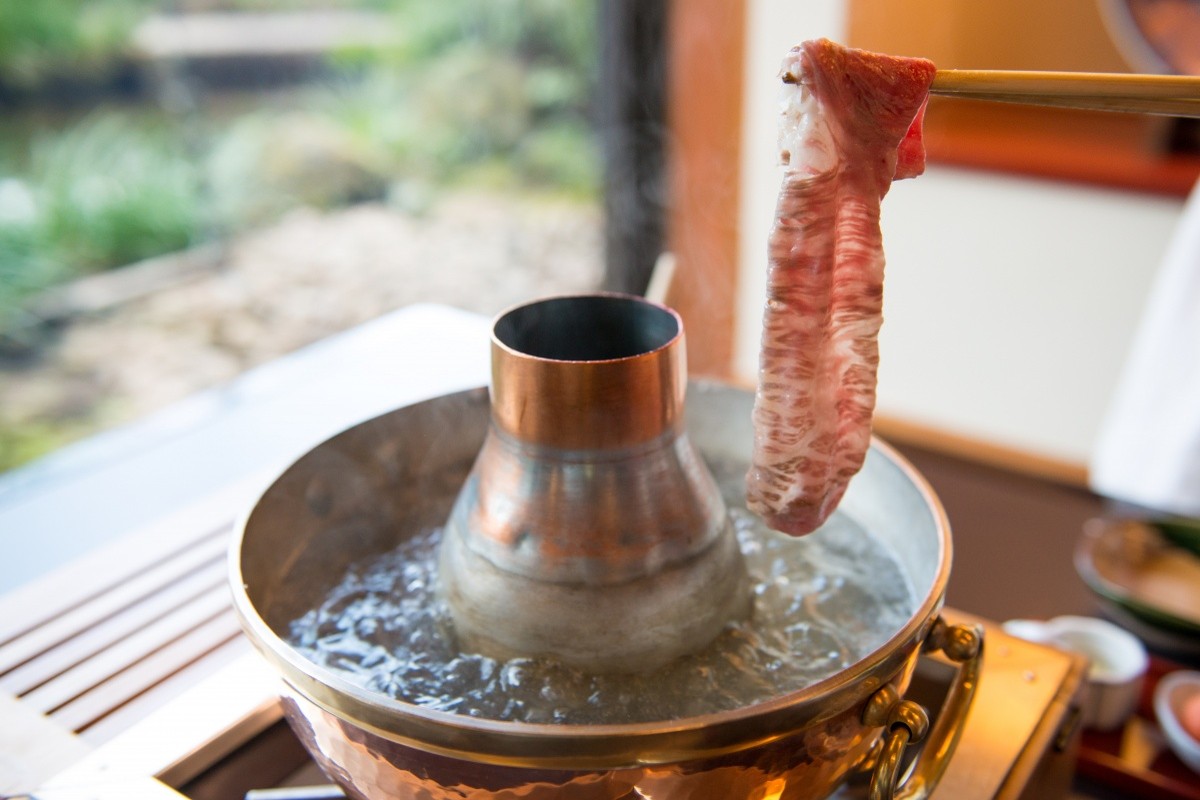
The most important key for having the best gourmet experience and enjoying the true taste of the Japanese Wagyu is master the minute details when having a shabu-shabu meal. After a detailed explanation and demonstration by Japanese connoisseur Mayumi Satoi, the actual experience of tasting Japanese Wagyu shabu-shabu has been a very touching experience. The stimulating taste from the entire meal still remains unforgettable! In addition, it is understood that Japanese people have recently taken on a custom of dipping the first slice of blanched Wagyu in sauces as a toast. As a shabu-shabu that uses a premium ingredient such as “Japanese Wagyu” as its primary ingredient, such a custom highlights the unique qualities of this lifestyle delicacy. So, you should pay attention to every detail when enjoying the shabu-shabu. I hope that everyone can properly enjoy the delicious meal like veteran connoisseurs, and learn about Japanese culture in the future while having proper Japanese Wagyu shabu-shabu.

